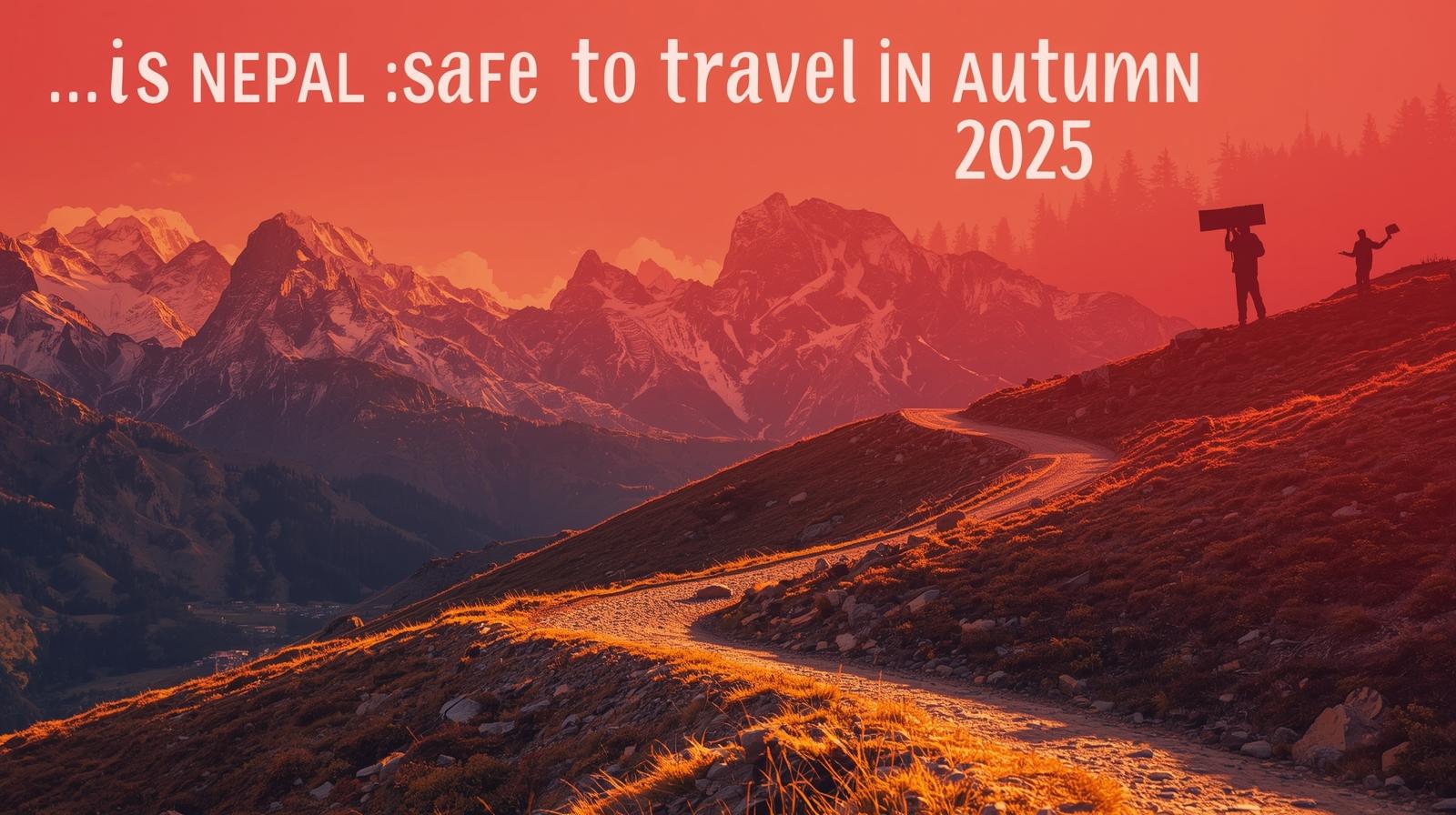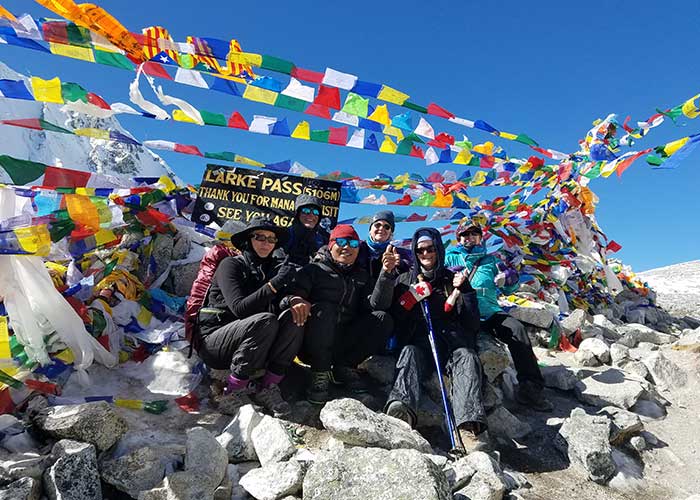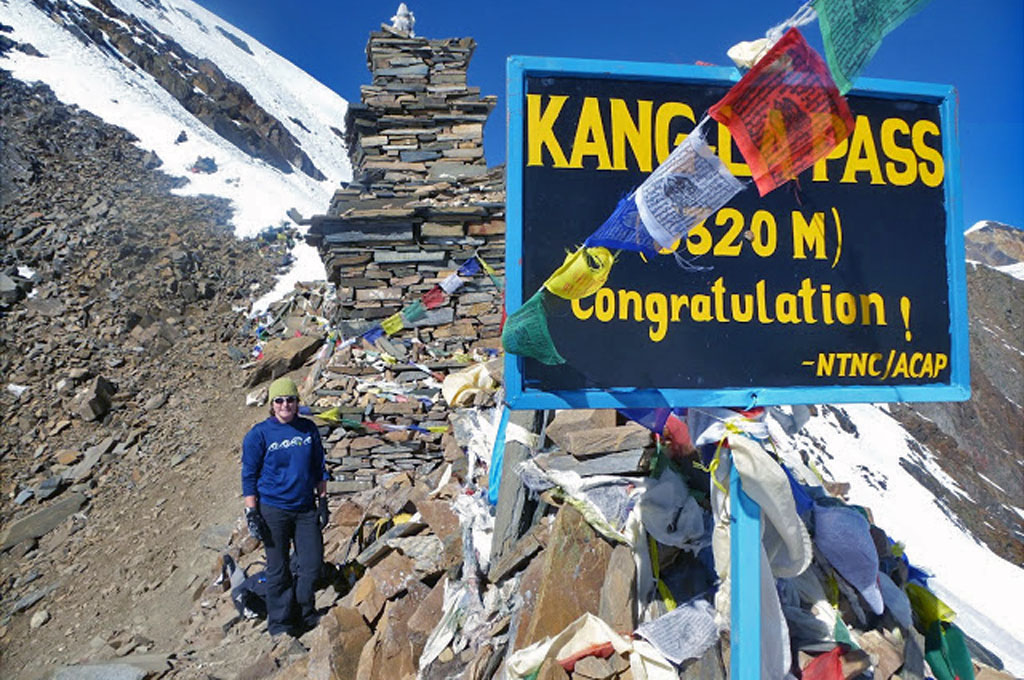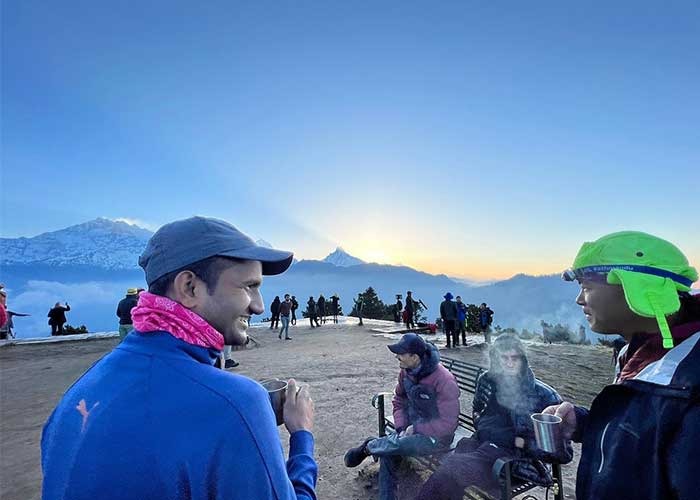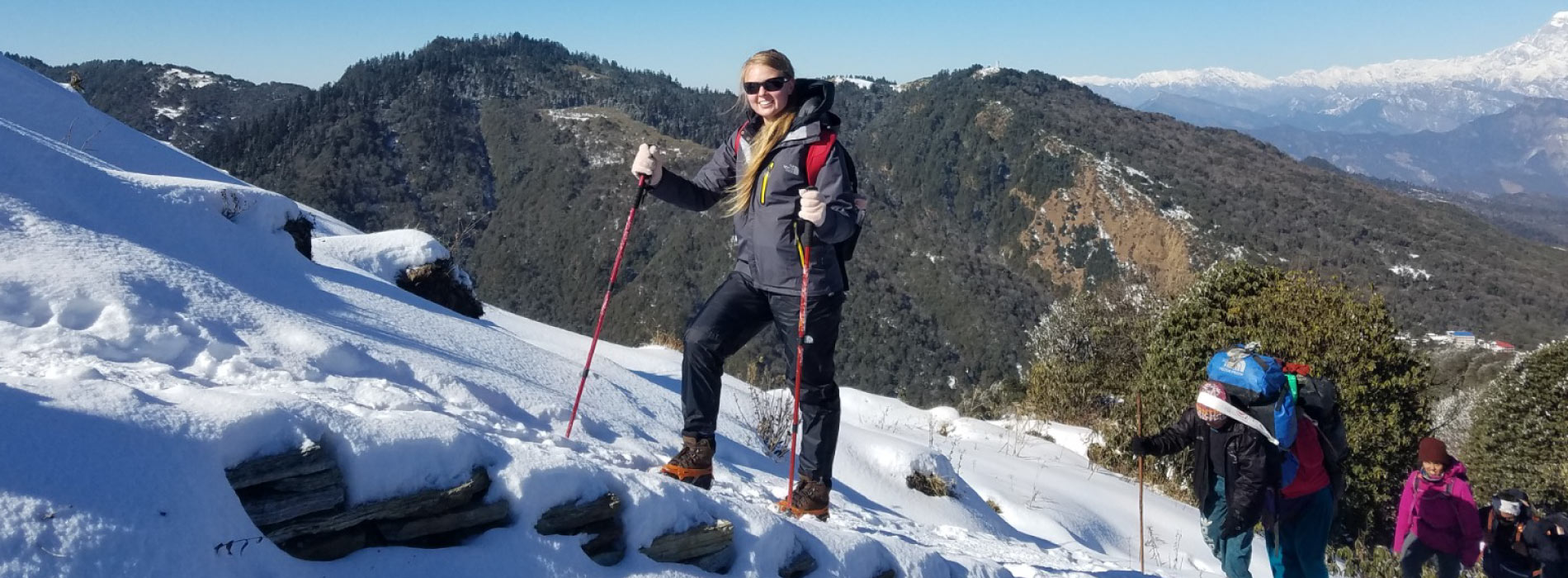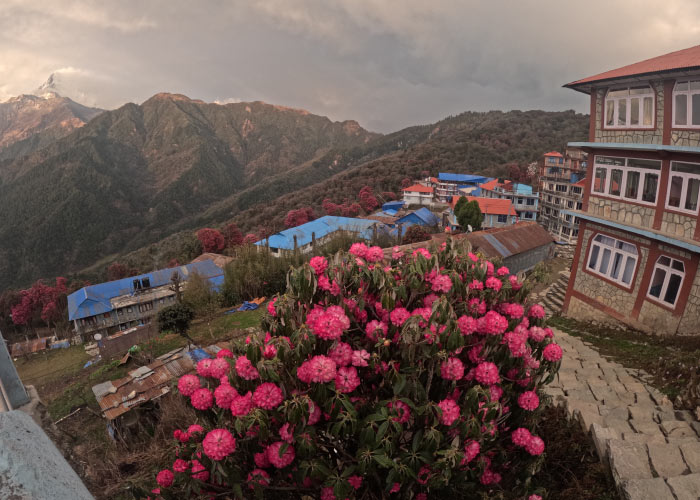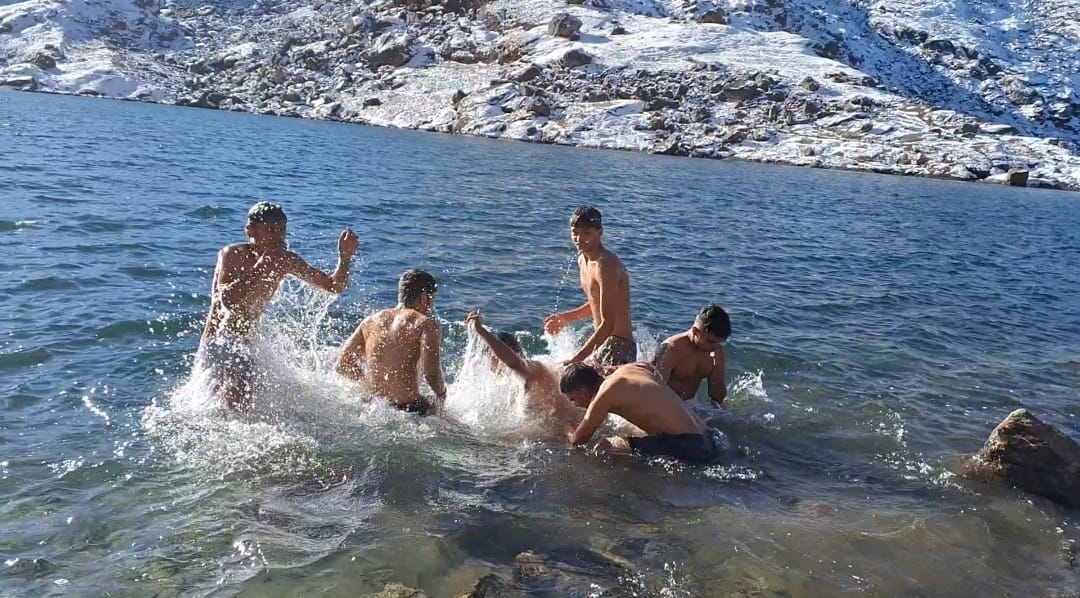Category: Nepal Travel Diaries
Blogs and travel news and updates from Nepal Mountain Trekkers.
2025
Is Nepal Safe to Travel in Autumn 2025 Amid Protests?
Short answer: Yes — Nepal is safe for travelers this autumn. While recent protests have drawn headlines, they are mainly centered in Kathmandu’s political areas and do not affect the trekking routes or major tourist regions. For most visitors, Nepal remains a welcoming and peaceful destination, especially in the Himalayas where life goes on as usual.
Why the Protests Shouldn’t Worry Travelers
The demonstrations in Nepal have been driven by frustration with corruption and economic inequality. These events are largely urban-focused and political in nature, taking place mainly in specific areas of Kathmandu Valley. While news coverage can make the situation sound alarming, daily life for locals and visitors outside those pockets has continued with little disruption.
Importantly, the government and local tourism authorities are committed to ensuring the safety and smooth experience of international guests. Tourism is Nepal’s lifeline, and travelers are not the target of these protests.
What Travelers Can Expect
Kathmandu & Major Cities: Some rallies and road closures may occur, but tourist-friendly areas like Thamel remain accessible and safe. Guides and agencies advise avoiding protest zones, which are easy to identify.
Trekking Regions (Everest, Annapurna, Langtang): Completely unaffected. The mountains remain as serene and beautiful as ever, and trekking operations are running normally.
Transport: Tribhuvan International Airport is open and functioning. Occasional delays may happen, but they are rare.
Tourist Hubs (Pokhara, Chitwan, Lumbini): Calm and welcoming, with no major disruptions.
Why Autumn 2025 Is Still the Best Time to Visit Nepal
Stable trekking environment: Trails in Everest, Annapurna, and Langtang are fully operational.
Clear skies & perfect weather: Autumn offers the best visibility and mild conditions for trekking.
Cultural vibrancy: Festivals like Dashain and Tihar bring color and joy across the country.
Warm hospitality: Nepalis are known for their kindness, and travelers will find locals even more eager to share their culture during this time.
Safety Tips for Peace of Mind
Stick with a registered trekking agency for reliable updates and support.
Avoid large gatherings in city centers.
Carry some extra cash (USD or NPR) for convenience.
Get travel insurance that includes trip interruptions.
Head directly to trekking regions where life is peaceful and tourism thrives.
Final Thoughts
Nepal has always been a country that welcomes visitors with open arms, even during times of political change. The recent protests are a sign of internal challenges, but they are not a threat to travelers. Autumn 2025 remains the ideal season to trek, explore cultural heritage sites, and enjoy the breathtaking landscapes of the Himalayas.
If you’ve been dreaming of trekking to Everest Base Camp, exploring the Annapurna Circuit, or visiting Pokhara’s serene lakes, there is no reason to postpone. With a little awareness in city areas and guidance from trusted operators, your journey to Nepal will be safe, memorable, and truly rewarding.
FAQs About Traveling to Nepal in Autumn 2025
Is Nepal safe for tourists during the protests?
Yes, Nepal is safe for tourists. The protests are centered in political areas and do not affect trekking or major tourist destinations.
Is it safe to trek in Everest, Annapurna, and Langtang in 2025?
Absolutely. All trekking routes are open and running smoothly, with no disruptions in the mountain regions.
Are flights to Nepal operating normally?
Yes, Tribhuvan International Airport and domestic flights are operating. Any delays are minimal and services remain reliable.
Is Kathmandu safe for travelers?
Yes, Kathmandu is safe. Tourists just need to avoid protest sites, which are easy to identify, while areas like Thamel remain vibrant and welcoming.
Can I travel with my family to Nepal in Autumn 2025?
Yes, Nepal is safe for family travel. Trekking regions, cultural sites, and tourist hubs like Pokhara and Chitwan are calm and family-friendly.
Will protests affect tourism in Nepal?
No, tourism is running as usual. Licensed trekking agencies, hotels, and guides are fully operational, ensuring travelers have a smooth experience.
2025
The Ultimate Guide to Music in Nepal: A Trekker’s Cultural Symphony
Music in Nepal is more than just sound—it’s the heartbeat of the Himalayas, echoing through ancient valleys, bustling Kathmandu streets, and remote trekking trails. For adventurers exploring Nepal’s majestic mountains, music adds a layer of cultural depth to every step. Whether you’re humming Resham Firiri with porters on the Annapurna Circuit or listening to ritual chants during a festival in Mustang, Nepali music connects you to the soul of this diverse nation. At Nepal Mountain Trekkers, we believe that a trek isn’t complete without immersing in these melodies. In this comprehensive guide, we’ll explore the history, genres, instruments, festivals, iconic songs, foreign influences, and modern scene of Nepali music, helping you plan a journey where trails and tunes intertwine.
The History of Music in Nepal: From Ancient Roots to Modern Fusion
Nepal’s musical heritage dates back over 2,000 years, shaped by its geography, ethnic diversity, and religious influences. The country’s position between India and Tibet has blended Hindu Vedic traditions with Buddhist chants, creating a unique soundscape. In ancient times, music was integral to rituals and storytelling. Vedic hymns, chanted in Sanskrit during temple ceremonies, laid the foundation for classical Nepali music, emphasizing devotion and spirituality. Maithili music, one of the oldest forms in South Asia, originated in the Mithila region (now split between Nepal and India) and featured lyrical ballads with themes of love and mythology.
During the medieval Malla dynasty (12th–18th centuries), Kathmandu Valley became a hub for sophisticated court music. Kings established royal courts where musicians composed ragas—influenced by North Indian classical styles—performed with intricate melodies and rhythms. Folk music, meanwhile, flourished in rural areas, passed orally through generations. Ethnic groups like the Newars developed complex orchestral traditions for festivals, while hill communities like the Gurungs and Tamangs created work songs for farming and herding. The Gandharva community, known as traveling minstrels, played a key role in preserving folk tales through music.
The 19th century saw Western influences creep in via British colonial ties in India, but it was the mid-20th century that transformed Nepali music. Radio Nepal, established in 1951, broadcasted folk tunes nationwide, popularizing songs like Resham Firiri. The 1960s hippie era brought global rock, leading to fusion genres. Today, Nepali music thrives as a mix of tradition and modernity, with urban youth blending hip-hop and electronic beats with ancient rhythms. This evolution mirrors Nepal’s cultural resilience, making it a living soundtrack for trekkers seeking authentic experiences. Recent revivals, as noted in 2025 studies, focus on restoring nearly extinct instruments and folk genres amid globalization.
Genres of Nepali Music: A Diverse Melody of Traditions and Innovations
Nepali music spans a wide spectrum, reflecting over 125 ethnic groups and influences from South Asia and beyond. Folk music dominates, rooted in everyday life and nature. Lok geet (folk songs) vary by region: in the Terai lowlands, Tharu communities sing rhythmic harvest tunes with themes of rural hardships and joys, while Himalayan Sherpas perform devotional chants inspired by Tibetan Buddhism, often incorporating spiritual motifs from nature and ancestry.
Classical music, influenced by Indian ragas, is performed in temples and courts, often during religious ceremonies like bhajans (devotional songs) praising deities with harmonious vocals and simple percussion. Ratna music, a 20th-century innovation named after composer Ratna Das, blends classical structures with patriotic and romantic lyrics, emerging post-democracy in 1951 as a symbol of national identity.
Ethnic genres add richness: Newar music features intricate rhythms for festivals, Gurung rodhi sessions involve group singing and dancing around fires, and Kirat (Rai/Limbu) music includes fast-paced sakela dances with agricultural themes. Pop and rock surged in the 1990s, with bands fusing Western styles. Nep-hop (Nepali hip-hop) addresses social issues like inequality and migration, pioneered by artists in the 2000s. Rock incorporates folk elements for a unique “Nep-rock” sound, while electronic and jazz fusion are rising in urban areas like Kathmandu and Pokhara, with events like Jazzmandu showcasing improvisational blends.
For trekkers, folk genres shine—songs sung around campfires evoke the mountains’ spirit, turning hikes into cultural immersions. In 2025, genres continue evolving, with digital platforms amplifying fusion tracks that mix traditional beats with global EDM.
Traditional Musical Instruments: The Sounds That Echo Through the Himalayas
Nepali instruments are handcrafted masterpieces, often made from local materials like bamboo, wood, and animal skins. They vary by ethnicity and region, adding distinct flavors to music. The evolution of these instruments traces back to ancient Vedic times, with influences from India and Tibet leading to innovations like hybrid string-percussion designs.
| Instrument | Description | Cultural Role | Common Use in Trekking/Festivals |
|---|---|---|---|
| Madal | A double-headed hand drum with leather skins stretched over a wooden body, tunable for varying pitches. It produces deep, resonant beats through palm strikes and finger taps, allowing complex rhythms. | Central to folk music; symbolizes unity in community gatherings and is believed to ward off evil spirits in rituals. | Ubiquitous on trails; porters play it during rest stops for morale-boosting songs, especially in hill regions like Gorkha. |
| Sarangi | A bowed string instrument carved from a single piece of wood (often sal tree), with four gut strings and a horsehair bow. It mimics the human voice with melancholic, sliding tones (glissando). | Used by Gandharva minstrels for storytelling; represents nomadic hill life and emotional expression in laments. | Heard in Mustang villages during festivals like Tiji, accompanying epic tales of kings and deities. |
| Bansuri | A bamboo flute with six to eight finger holes, side-blown for soft, melodic notes ranging from breathy lows to piercing highs. | Linked to pastoral and spiritual themes; Lord Krishna is often depicted playing it, symbolizing divine love. | Trekkers encounter it in Gurung areas along Annapurna, evoking serene mountain landscapes during evening gatherings. |
| Tungna | A four-stringed lute from the Himalayas, with a resonator box covered in animal skin, plucked with fingers for bright, twangy sounds. | Sacred in Tamang and Sherpa rituals; signifies cultural identity in high-altitude communities, often used in shamanic healing. | Played during Losar celebrations on Everest treks, blending with chants for New Year blessings. |
| Damphu | A circular frame drum with a single goatskin head, beaten with hands or sticks for sharp, echoing beats. | Iconic to Tamang music; used in dances and shamanic rituals to invoke spirits and celebrate life cycles. | Common on Langtang trails; energizes group dances at teahouses, especially during harvest seasons. |
| Dhime | A large cylindrical drum played with sticks on both ends, producing booming, thunderous rhythms that carry over long distances. | Newar specialty for processions; symbolizes power and festivity, with roots in medieval court music. | Essential in Kathmandu Jatras like Indra Jatra, audible from afar, and sometimes echoed in valley treks. |
| Panche Baja | An ensemble of five instruments (shehnai oboe, damaha kettledrum, tyamko small drum, jhyali cymbals, dholak barrel drum), creating harmonious fanfares with layered rhythms. | Used in weddings and auspicious events; brings good luck and is tied to Hindu traditions for prosperity. | Performed at village welcomes on Annapurna Circuit for cultural exchanges, often during marriage seasons. |
These instruments are not just tools but cultural artifacts, often decorated with carvings of deities or nature motifs. Modern bands repurpose them for fusion, preserving heritage while innovating. Over 200 original instruments have been identified, with about 108 still in use, highlighting Nepal’s rich sonic diversity.
Music in Festivals and Jatras: Celebrations That Resonate with Rhythm
Festivals in Nepal are sonic spectacles, where music intertwines with dance, rituals, and community spirit. Jatras (processions) in the Kathmandu Valley are vibrant, with Newar orchestras leading masked dances and chariot pulls, often lasting days and drawing thousands.
Indra Jatra, held in September (September 17-24, 2025), honors the rain god Indra. It features dhimay drums and cymbals clashing in rhythmic frenzy, accompanying the Kumari (living goddess) parade through Durbar Square. The music builds tension, symbolizing monsoon’s end and harvest’s start—perfect for post-monsoon trekkers visiting Kathmandu, where street performers add impromptu folk tunes.
Bisket Jatra in Bhaktapur (April 13-17, 2025) marks the Nepali New Year with tug-of-war games and processional music. Panche baja ensembles play uplifting tunes, drawing crowds to Durbar Square amid colorful chariot crashes symbolizing renewal.
In trekking regions, festivals like Tiji (14th to 16th May 2026, Lo Manthang, Mustang) celebrate good over evil. Monks in colorful masks perform cham dances to drums and long horns, creating eerie, echoing sounds in the walled city. Trekkers timing their Upper Mustang hike for Tiji experience this as a highlight, blending adventure with cultural immersion, with post-dance folk sessions around fires.
Yartung Mela (August 28-30, 2025, Upper Mustang) is a joyous horse-racing festival. Folk songs and damphu drums fill the air, with locals dancing in traditional attire. It’s a multi-day event of merriment, ideal for Annapurna or Mustang circuit extensions, featuring archery contests and communal feasts enhanced by music.
Other trekking-aligned festivals include Lhosar (February 28, 2025, Himalayan regions), with Tamang selo dances and damphu rhythms celebrating the Tibetan New Year in places like Solu-Khumbu, and Mani Rimdu (October 20-22, 2025, Tengboche Monastery), featuring masked dances and ritual chants near Everest Base Camp.
Additional festivals enrich the calendar: Dashain (September 22-October 7, 2025), Nepal’s longest Hindu festival, involves devotional songs and family gatherings with madal-accompanied bhajans honoring goddess Durga. Tihar (October 20-24, 2025), the festival of lights, features deusi-bhailo groups singing door-to-door for blessings, blending folk tunes with dances. Chhath Puja (November 7-10, 2025) in Terai regions includes riverbank rituals with melodic hymns. Teej (August 27, 2025) sees women singing and dancing in red saris for marital happiness, often with dohori (call-response) songs. Maha Shivaratri (February 26, 2025) at Pashupatinath Temple buzzes with bhajans and all-night vigils. Maghe Sankranti (January 14, 2025) celebrates winter solstice with hill folk music and feasts. Holi (March 14, 2025), the color festival, erupts in playful songs and dances. Buddha Jayanti (May 12, 2025) at Boudhanath features serene chants and processions. Fagu Purnima (March 14, 2025), Thakali New Year, includes lively music in Mustang. Ubhauli/Udhauli (May/November) for Kirat communities involve sakela dances with dhol drums honoring nature.
These events showcase music’s role in preserving identity, offering trekkers authentic connections beyond trails, with 2025 seeing increased eco-friendly tourism integrations.
Mountain Music and Trekking Experiences: Harmonies on the Trail
For trekkers, Nepal’s mountains are a natural amphitheater. Sherpa and Tamang porters often sing work songs to maintain pace, their voices carrying over ridges with themes of endurance and home. In Solu-Khumbu, Buddhist chants from monasteries like Tengboche provide meditative soundtracks for Everest hikes, blending gongs and conch shells for spiritual ambiance.
Gurung villages on the Annapurna Circuit resonate with ghatu dances and madal beats during evenings, where women in traditional attire perform storytelling routines about legends and love. Mustang’s arid landscapes host tungna-plucked ballads recounting ancient trade routes, often shared around yak-dung fires. Music fosters bonds—join a teahouse sing-along, and you’ll feel part of the community, learning phrases that bridge languages.
In remote Dolpo, shamanic rituals feature khin drums for healing ceremonies, adding mysticism to treks. Festivals amplify this: during Tiji or Mani Rimdu, trekkers witness full orchestras, turning paths into cultural corridors.
At Nepal Mountain Trekkers, our cultural treks include music workshops, where guides teach simple madal rhythms or Resham Firiri lyrics for immersive experiences, enhancing your journey with local harmonies.
Resham Firiri: Nepal’s Iconic Folk Song and Its Enduring Legacy
Resham Firiri is Nepal’s unofficial trekking anthem, a joyful folk tune that captures the essence of Himalayan life. Composed by Buddhi Pariyar and first recorded in 1969 by Sunder Shrestha and Dwarika Lal Joshi at Radio Nepal, it translates to “silk fluttering.” The lyrics evoke weaving silk, playful love, and nature’s beauty: “Resham firiri, resham firiri, udaera jauki paari dada ma bhanjyang bhanjyang…” (Silk fluttering, fluttering away to the hill beyond the pass). Interpretations vary—some see it as a metaphor for fleeting love or a lover’s scarf waving in the wind, while others view it as a wandering soul seeking freedom in the mountains.
Rooted in hill folk traditions from the Gandaki region, its simple melody—often with madal and sarangi—makes it easy for groups to sing, fostering camaraderie on trails. Trekkers hear it on paths from Annapurna to Langtang, symbolizing hospitality and the nomadic spirit. Though not the national anthem (Sayaun Thunga Phulka Hami is), it’s a cultural icon, remixed in modern pop (e.g., electronic versions in 2025 festivals) while preserving its roots. The song’s pain of separation and joy of reunion resonate with migrants and lovers, making it timeless for Nepal’s diaspora.
Modern Nepali Music and Bands: Fusion in the Spotlight
Nepal’s modern scene exploded in the 1990s, blending tradition with rock, pop, and hip-hop. Pioneers like Nepathya (formed 1990) fuse folk with rock—lead singer Amrit Gurung’s hits like “Resham”, “Bheda ko Oon Jasto”, “Chhekyo Chhekyo” use madal alongside guitars, touring globally with a 2025 USA tour spreading Himalayan vibes.
1974 AD, Kathmandu’s rock staple since 1994, mixes hard rock with Nepali lyrics. Songs like “Jati Maya Laye Pani” and “Yo Man Ta Mero Nepali Ho” address love and society, earning them legendary status; in 2025, they headlined emotional concerts at Hyatt Ground.
Other bands: Cobweb (heavy metal pioneers since 1993) released “SHATRU… ma afai” in 2025, keeping rock alive; Albatross and other bands add alternative edges; Kutumba, as well as, Kuma Sagar and the Khowpa focuses on instrumental folk fusion.
Festivals like Jazzmandu showcase these bands, blending with international acts. Streaming platforms amplify them, making Nepali music accessible worldwide, with 2025 seeing new releases in Nep-hop and electronic fusions.
Where Foreigners Can Enjoy Live Music in Nepal
As a foreigner exploring Nepal, live music offers an electrifying way to connect with local culture. Kathmandu’s Thamel district is a hotspot, with venues like Purple Haze Rock Bar hosting high-energy rock nights with local bands covering Nepali hits and international classics—expect crowds on Fridays/Saturdays. LOD – Lord of the Drinks in Thamel blends cocktails with live fusion sets, while Sam’s Bar and Iris Pub offer intimate acoustic sessions. Reggae Bar in Thamel delivers laid-back vibes with reggae and folk covers, and Kings Lounge Kathmandu features themed nights with top acts. Other favorites include BlackBird for jazz, Hole in the Wall for indie, Club OMG for dance music, Rum Doodle for trekker hangouts with occasional bands, Senate Club for upscale gigs, Ibyza Lounge & Disco for electronic, and Trekkers Bar for casual folk.
In Pokhara’s Lakeside, Old Blues Bar stands out for live blues and rock bands nightly, with great food and views. Busy Bee Cafe hosts acoustic sets by local talents, Irish Pub offers lively covers, and Club Nasha pumps electronic with occasional live DJs. Mustang Pub mixes rustic charm with pub tunes, All That Jazz specializes in jazz jams, Movie Garden for open-air folk, and Ozone Premier Club for upscale fusion. Events like LG Fest (February 2025) bring major bands.
On Everest treks, Namche Bazaar boasts The Hungry Yak Live Music Bar—the world’s highest (3,440m)—with live bands, pizza, and cheap drinks; bands perform well into nights, often Nepali rock or covers. Irish Pub in Namche offers occasional live sessions with trekker jams. In Lukla or Tengboche, teahouses host informal folk nights, while Solu-Khumbu spots like Khumjung feature Sherpa chants. Music is seasonal—check for festival overlaps.
Music elevates trekking—book your cultural adventure today at nepalmountaintrekkers.com and let Nepal’s melodies guide your path!
2025
Nepal Mountain Trekkers Wins Tripadvisor Travellers’ Choice Award 2025!
One of the Top-Rated Trekking Companies in Nepal, Recognized Globally by Real Travelers
If you’ve ever dreamed of standing beneath the towering Himalayan peaks or wandering through timeless mountain villages—you’re not alone. Thousands of adventurers from across the world have journeyed with Nepal Mountain Trekkers, returning home with memories of awe, warmth, and wonder.
And now, thanks to their stories and heartfelt reviews, we’re proud to share this moment with you:
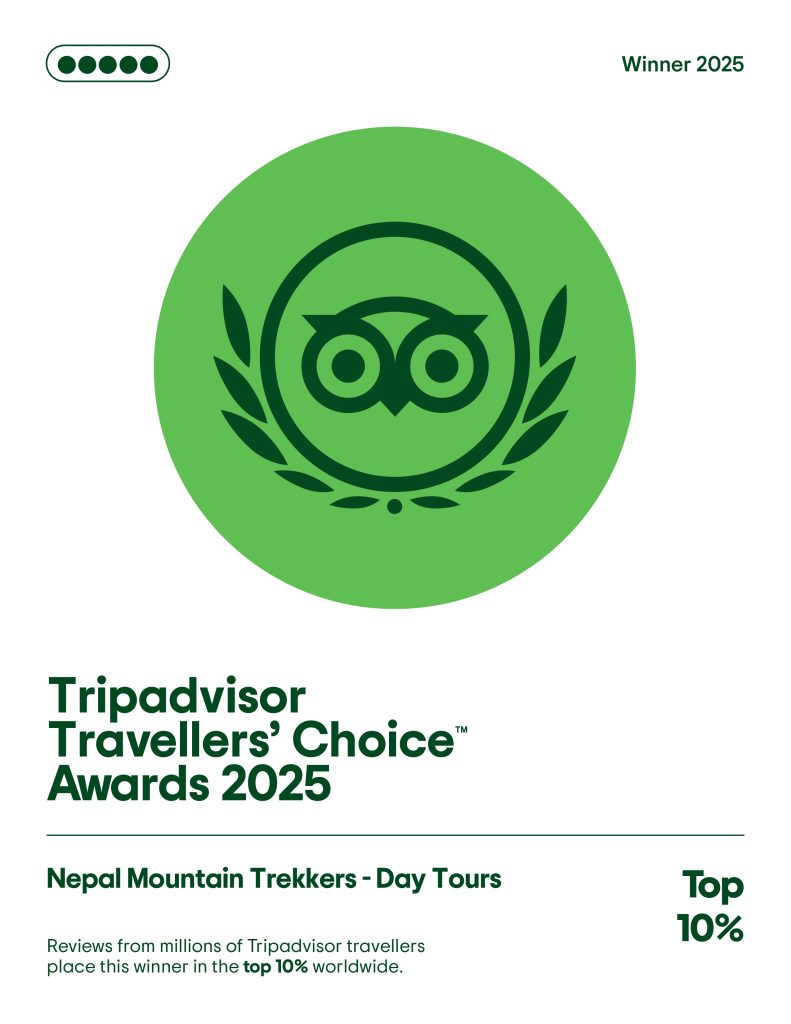
🎉 Nepal Mountain Trekkers has received the Tripadvisor Travellers’ Choice Award 2025! 🎉
This prestigious honor places us among the top 10% of travel experiences worldwide. It’s more than a badge—it’s proof that meaningful travel, guided by trust and connection, still matters deeply.
What Is the Tripadvisor Travellers’ Choice Award?
Each year, Tripadvisor combs through millions of real traveler reviews to recognize businesses that consistently deliver outstanding service. The Travellers’ Choice Award is Tripadvisor’s highest accolade—earned by those who go above and beyond to create truly unforgettable experiences.
It’s not a popularity contest. It’s not about ad spend or social hype. It’s about you—your words, your stories, your stars, your trust.
👉 Read Our Tripadvisor Reviews
What Our Trekkers Say
“Everything was well organized—from planning to the final farewell. Our guide Manu was knowledgeable, friendly, and made the journey unforgettable. I’ll definitely be back!”
— James, UK
“We did the Manaslu Circuit and Tsum Valley. The landscapes were surreal, and cultural encounters deeply moving. Everything was arranged perfectly.”
— Nina, Germany
“I traveled solo and was nervous, but the NMT team felt like family from day one. They even arranged a ghost permit so I could legally trek Manaslu alone. Amazing people!”
— Maria, Spain
“From Kathmandu to Pokhara, every detail was seamless. Upper Mustang was like walking through a dream, and Sumang’s storytelling made it even more magical.”
— Lee, Singapore
Words that come up again and again?
✅ Safety
✅ Warmth
✅ Expertise
✅ Authentic cultural connection
Why So Many Travelers Choose Nepal Mountain Trekkers
1. Tailored Itineraries
Whether you want Everest’s drama, the peaceful beauty of Langtang, or hidden gems like Khopra Ridge, we craft treks that match your style, time, and pace.
2. Exceptional Local Guides
Our guides—like Shiva, Min, TB, Sujan, Manu, and Suman—are the heart of our team. Fluent in English, deeply rooted in local culture, and certified by the Nepal Tourism Board, they bring mountains and stories to life.
3. Ethical and Sustainable Travel
We hire locally, respect communities, and trek lightly. With us, you’re not just passing through—you’re contributing.
4. Clear Communication & Support
From your first inquiry to the farewell dinner, we offer honest pricing, 24/7 availability, and zero hidden costs.
Our Most Loved Treks
Here are the treks that travelers rave about most:
- 🏔️ Everest Base Camp Trek – iconic, inspiring, unforgettable
- 🌀 Annapurna Circuit and Base Camp – dramatic landscapes and rich culture
- 🕉️ Manaslu Circuit & Tsum Valley – remote, spiritual, and raw beauty
- 🌲 Langtang Valley & Tamang Heritage Trail – close to Kathmandu, full of culture
- 🐎 Upper Mustang Trek – the last forbidden kingdom
- 🧘♀️ Khopra Danda Trek – hidden ridgelines, fewer crowds
- ☀️ Day Tours in Kathmandu & Pokhara – for a short yet rich taste of Nepal
👉 Explore All Our Treks & Tours in Nepal
We Trek With Purpose
Travel today should mean something. It should uplift. Educate. Inspire. That’s our philosophy. That’s why we:
- Support local livelihoods
- Avoid overtourism hotspots when possible
- Promote off-the-beaten-path routes
- Respect cultural traditions and environmental boundaries
“This wasn’t just a trek—it was a soul-deep journey. I came for the mountains but left with friendships and a deeper understanding of Nepal.”
Frequently Asked Questions
Can I trek solo in Nepal?
Yes. We help solo trekkers arrange restricted permits (like the Manaslu ghost permit) without hassle.
Can I customize my trip?
Absolutely! From route to accommodation to pace—we personalize everything.
Are your guides licensed and experienced?
Yes. All are certified by the Nepal Tourism Board, with first aid training and years of experience.
Can I book a trek last-minute?
Often, yes. Just message us and we’ll see what’s possible!
Ready for Your Next Adventure?
Whether it’s your first Himalayan trek or your tenth, we’ll help you plan the journey of a lifetime—with heart, safety, and soul.
📍 Website: www.nepalmountaintrekkers.com
📧 Email: info@nepalmountaintrekkers.com
📞 WhatsApp/Viber: +977-9851276377
A Heartfelt Thank You ❤️
To every guest who trusted us, reviewed us, recommended us, or simply walked with us—we’re here because of you.
Here’s to more sunrises on the trail, more laughter in teahouses, and more journeys that change us forever.
#TravellersChoice2025 | #NepalMountainTrekkers | #TrekkingNepal
#TripadvisorAward | #ExploreHimalayas | #ResponsibleTravel
2025
Trekking in Nepal – Best Routes for Autumn 2025 & Spring 2026
If you’re planning a trekking adventure in autumn 2025 or spring 2026, Nepal is calling. These two seasons offer the clearest mountain views, safest trails, and most reliable weather—making them the most searched times to trek in the Himalayas.
At Nepal Mountain Trekkers, we’ve guided thousands of trekkers across the country’s most stunning routes. In this guide, we share the top treks, costs, ideal booking windows, and what to expect on and off the trail in Nepal during these peak seasons.
🍁 Why Trek Nepal in Autumn 2025?
Autumn (mid-September to late November) is Nepal’s prime trekking season. After the monsoon ends, skies clear, humidity drops, and the trails dry out—creating ideal trekking conditions.
Best Features of Autumn Treks:
- Unobstructed views of Everest, Annapurna, Dhaulagiri, and more
- Perfect temperatures: warm days, cool nights
- Festival season: Dashain & Tihar cultural celebrations
Top Autumn Treks:
- Everest Base Camp Trek – 12–14 days
- Manaslu Circuit Trek – 14–16 days (restricted permit required)
- Annapurna Circuit Trek – 12–14 days (Thorong La Pass)
Book early: Autumn departures begin filling from June 2025.
🌸 Why Trek Nepal in Spring 2026?
Spring (March to mid-May) is Nepal’s second most popular trekking season. The hills explode in color with blooming rhododendrons, and the snowcapped peaks still shine in full glory.
Spring Highlights:
- Longer daylight and warmer conditions
- Rhododendron forests in full bloom
- Ideal for nature photography and beginner trekkers
Top Spring Treks:
- Mardi Himal Trek – 5–7 days (short, scenic)
- Langtang Valley Trek – 7–10 days (close to Kathmandu)
- Annapurna Base Camp – 8–10 days
Perfect for: Solo trekkers, nature lovers, and photographers.
💰 Trekking Cost Overview (2025–26)
| Trek | Duration | Estimated Cost (USD) |
|---|---|---|
| Everest Base Camp | 12–14 days | $1,350 – $1,600 |
| Annapurna Base Camp | 8–10 days | $950 – $1,200 |
| Manaslu Circuit | 14–16 days | $1,300 – $1,700 |
| Mardi Himal | 5–7 days | $750 – $950 |
| Poon Hill | 4–6 days | $600 – $850 |
All our packages include licensed guide, permits, meals, accommodations, and transfers. No hidden fees.
📆 When Should You Book?
- For Autumn 2025: Book by June–July 2025
- For Spring 2026: Book by November–December 2025
Note: Solo traveler? We can arrange group joins or use a ghost permit for restricted areas like Manaslu.
🎒 Essential Packing Checklist
- Down jacket and thermal base layers
- Waterproof trekking boots
- Sunglasses, sunscreen, lip balm
- Reusable water bottle + purification tablets
- First-aid kit + Diamox for altitude
- Headlamp and power bank
🌱 Travel Responsibly with Nepal Mountain Trekkers
We focus on safe, ethical, and sustainable trekking. Our guides are trained, licensed, and fairly paid. We promote plastic-free travel and use community-based accommodations wherever possible.
📩 Ready to Trek Nepal in 2025 or 2026?
We’re now accepting early inquiries for both autumn 2025 and spring 2026. Avoid price hikes, secure flights, and choose your route before peak rush begins.
📞 Contact us today to get a customized quote →
🔍 Frequently Asked Questions
When is the best time to trek in Nepal?
Autumn (Sep–Nov) and spring (Mar–May) are the best times due to stable weather, great visibility, and low risk of flight delays.
Do I need permits?
Yes. Most treks require a TIMS card and conservation area permits. Restricted treks (like Manaslu) require special permits, which we handle for you.
How fit do I need to be?
You should be comfortable walking 5–7 hours daily. Prior hiking experience helps, but beginner-friendly treks like Mardi Himal or Poon Hill are also available.
Can I trek solo?
Some routes allow solo trekking, but restricted regions like Manaslu require at least two trekkers. We arrange ghost permits if needed.
2025
Nar Phu Valley Trek with Kang La and Thorong La: The Hidden Gem of the Himalayas
What is the Nar Phu Valley Trek?
The Nar Phu Valley Trek with Kang La Pass and Thorong La is one of the most special adventures in Nepal. It takes you to the remote and untouched Nar and Phu valleys, close to the Tibetan border. This trek is perfect for people who want to explore something different than the usual Everest or Annapurna trekking trails.
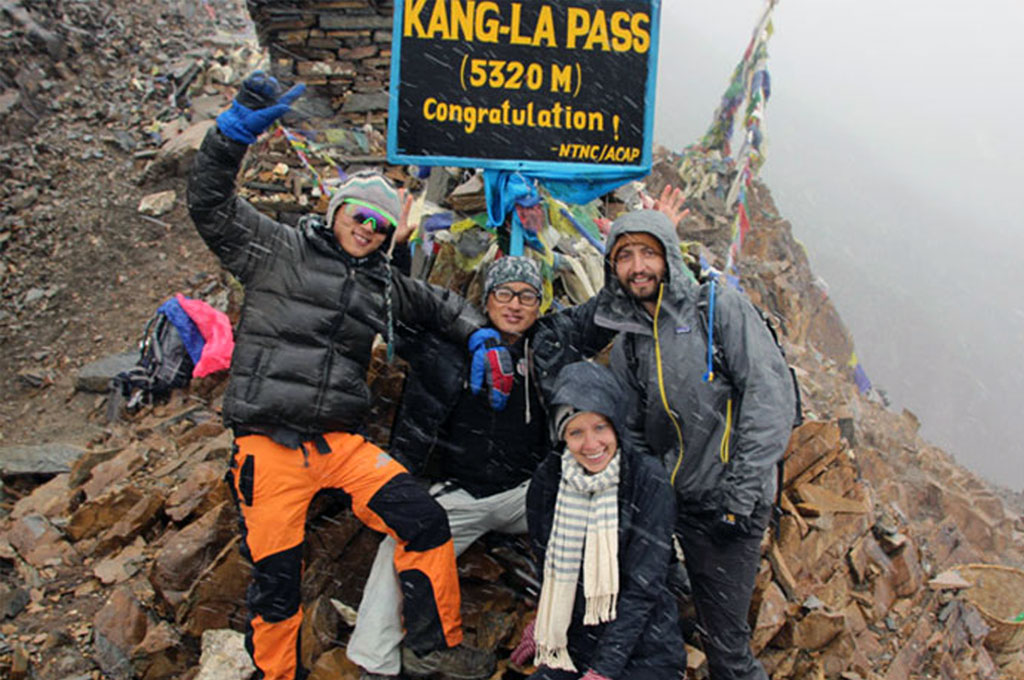
The route includes two big mountain passes: Kang La Pass (5,320 meters) and Thorong La Pass (5,416 meters). Along the way, you’ll walk through quiet villages, meet local people, visit ancient monasteries, and see beautiful Himalayan peaks like Annapurna II, Gangapurna, and Tilicho.
Why Choose the Nar Phu Trek with Kang La and Thorong La?
- It is less crowded than other famous treks.
- You get to see real Himalayan culture and lifestyle.
- You cross two high passes: Kang La and Thorong La.
- The trek joins the popular Annapurna Circuit Trek near Manang.
- It is a perfect mix of culture, adventure, and nature.
When Is the Best Time to Trek Nar Phu?
The best months for the Nar Phu Trek are March to May (spring) and September to November (autumn). During these times, the skies are clear, and the mountain views are amazing.
Can I trek to Nar Phu Valley in the monsoon?
Yes! The Nar Phu Valley is in the rain-shadow area, which means it does not get much rain even in monsoon (June to August). So, the Nar Phu Valley Trek can be a good monsoon trekking destination in Nepal too.
However, we recommend avoiding winter (December to February) for trekking in Nar Phu Valley unless you are very experienced. The passes are snowy and risky during this time so it could be challenging for a beginner trekkers.
How Difficult Is the Nar Phu Trek?
The Nar Phu Kang La Pass Trek is a moderately difficult trek in Nepal. It is suitable for people who are fit and love walking. You will need to walk 5 to 8 hours a day. The trail has many ups and downs, and you go above 5,000 meters.
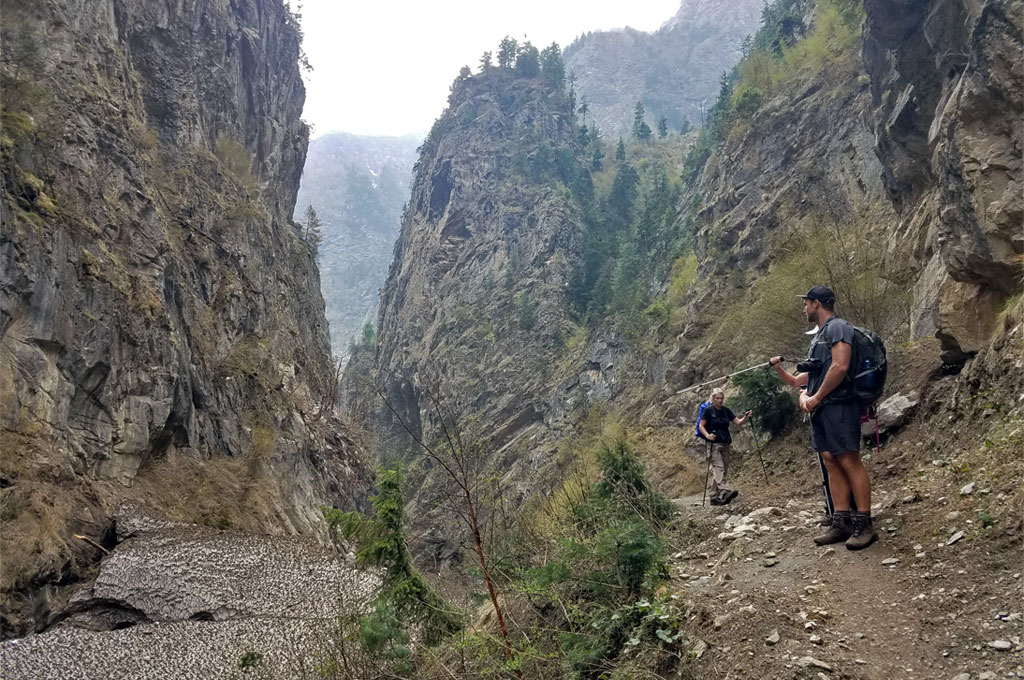
You don’t need to be a pro, but some trekking or hiking experience helps. The two high passes are tough, especially Kang La. But with the right guide and itinerary, you can do it!
Do You Need a Guide or Permits for Nar Phu Trek?
Yes! The Nar Phu Valley trek is in a restricted area of Nepal. So for trekking in Nar Phu Valley:
- You must go with a licensed guide.
- You need two trekkers minimum (but a ghost permit can be arranged).
- Permits needed for Nar Phu Trek:
- Nar Phu Restricted Area Permit
- Annapurna Conservation Area Permit (ACAP)
- TIMS Card (Trekkers’ Information Management System)
If you book with Nepal Mountain Trekkers, we take care of all permits and paperwork for you.
Nar Phu Valley Trek Itinerary (13–14 Days)
This is a common route of Nar Phu Valley Trek with Kang La Pass and Thorong La followed by trekkers:
Day 1: Drive from Kathmandu to Jagat
Day 2: Trek to Dharapani
Day 3: Trek to Koto
Day 4: Trek to Meta
Day 5: Trek to Phu Village
Day 6: Acclimatization day in Phu
Day 7: Trek to Nar Phedi
Day 8: Trek to Nar Village
Day 9: Cross Kang La Pass and trek to Ngawal
Day 10: Trek to Manang
Day 11: Trek to Yak Kharka
Day 12: Cross Thorong La Pass and reach Muktinath
Day 13: Drive or fly to Pokhara via Jomsom
Day 14: Return to Kathmandu
You can also extend your trek to Tilicho Lake, Ice Lake, or even Tsum Valley. Get in touch with us and receive your customized, tailor-made Nar Phu Trekking itinerary that best suits your specifications and requirements.
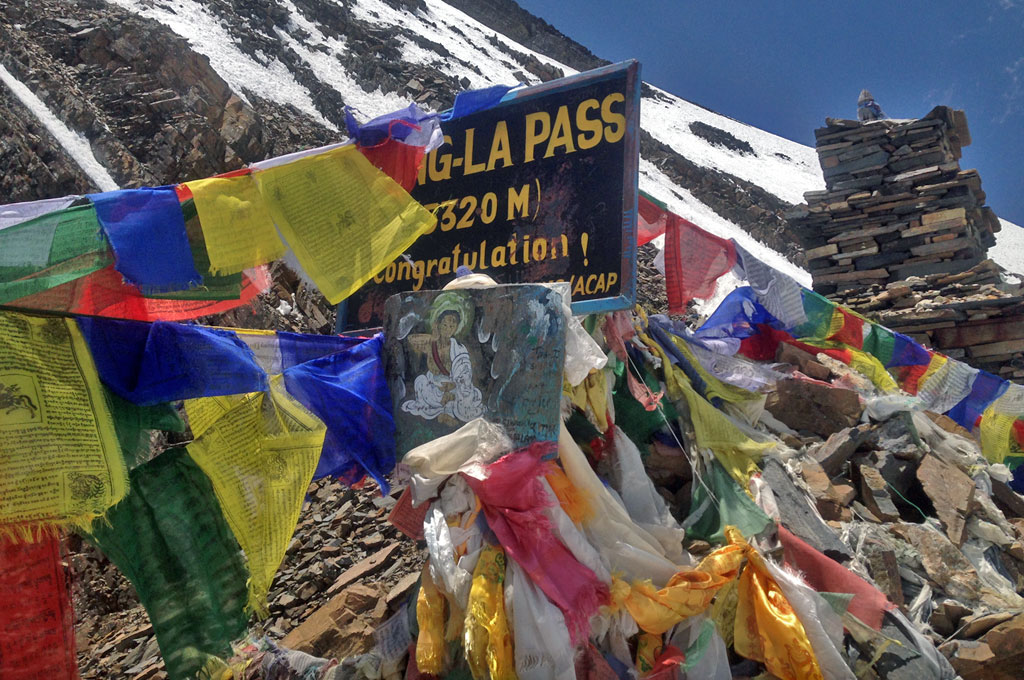
How Much Does the Nar Phu Kang La Pass Trek with Thorong La Cost?
The cost for Nar Phu Kang La Pass Trek with Thorong La depends on the group size, services, and how many days you plan.
For an idea of the cost overview to trek in Nar Phu Valley, here’s a basic idea of the expenses:
- Permits Cost: USD 100–120
- Guide Cost: USD 30–35 per day
- Porter (optional): USD 20–25 per day
- Food & Accommodation Cost: USD 25–40 per day
- Transportation Cost: USD 50–100 (Kathmandu–Jagat, Jomsom–Pokhara)
At Nepal Mountain Trekkers, we provide all-inclusive packages with no hidden costs. Or, if you would prefer to arrange just the guide and permits, and pay for other expenses by yourself, we can organize the Nar Phu Trek Guide Service as well.
Equipment List: What to Pack for Nar Phu Trek?
- Warm clothes (layers)
- Down jacket and sleeping bag (-10°C or lower)
- Trekking boots and socks
- Trekking poles
- Water bottles and purification tablets
- Sunscreen, sunglasses, and lip balm
- Power bank (charging costs extra in teahouses)
- First aid kit and medicine for altitude
Highlights of the Nar Phu Trek
- Hidden Tibetan-style villages of Nar and Phu
- Crossing the scenic Kang La Pass (5,320m)
- Walking through Manang, one of the most beautiful villages in Nepal
- Crossing the famous Thorong La Pass (5,416m)
- Visiting the holy temple of Muktinath
- Joining the classic Annapurna Circuit trail
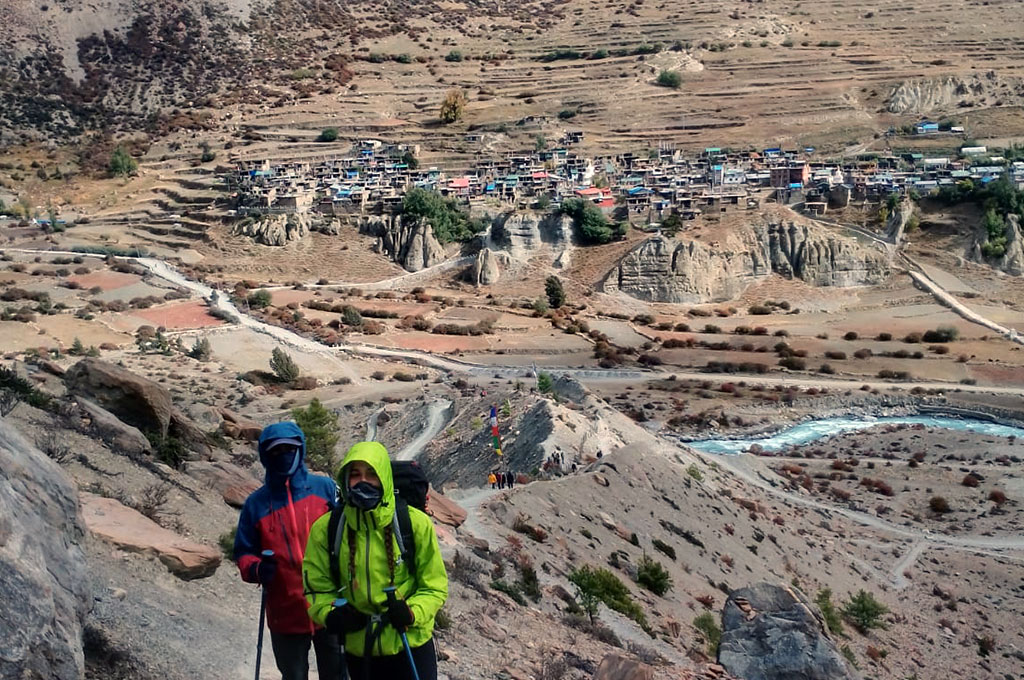
Nar Phu Trek vs Other Popular Treks in Nepal
| Trek Name | Crowds | Culture | Difficulty | Unique Points |
|---|---|---|---|---|
| Nar Phu Trek | Very low | Tibetan Buddhist | Moderate | Remote, 2 high passes |
| Annapurna Circuit | Medium | Gurung & mixed | Moderate | Classic route, many teahouses |
| Everest Base Camp | Very high | Sherpa Buddhist | Moderate | Close-up view of Mt. Everest |
| Manaslu Circuit Trek | Low | Tibetan-Gurung mix | High | Wild and remote experience |
Explore Related Treks
FAQs about Nar Phu Valley Trek
Q: Is Nar Phu Trek safe?
Yes. With proper acclimatization and a guide, it’s safe for most trekkers.
Q: Can I do the Nar Phu Valley trek solo?
No. You need a registered guide and must trek in a group of at least two (we can arrange a “ghost permit” if needed).
Q: Can beginners do this trek?
If you are fit and determined, yes. But some prior hiking experience is helpful.
Q: How long is the Nar Phu trek?
Usually 13–14 days, but can be longer with side trips.
Q: Do I need travel insurance for Nar Phu Trek?
Yes! Make sure your insurance covers trekking above 5,000 meters and emergency helicopter rescue.
Final Thoughts: Why Trek Nar Phu with Nepal Mountain Trekkers?
We specialize in remote and unique trekking in Nepal. Our guides are experienced, our itineraries are flexible, and your safety is our top priority. From permits to final drop-off, we take care of everything.
Let’s discover the hidden kingdom of Nar and Phu together!
👉 Contact Us today to plan your Nar Phu adventure!
2025
Tour and Trekking in Nepal: Your Ultimate 2025 Guide
Thinking of going on a trekking tour in Nepal? You’re in the right place. Nepal isn’t just a destination — it’s the world’s capital of trekking. With trails that wind through ancient villages, rhododendron forests, and past the tallest peaks on Earth, there’s no better place to walk, explore, and reconnect with nature.
Whether you’re a first-time hiker or an experienced adventurer, this guide explains everything you need to know about tour and trekking in Nepal, including the best treks, how to plan, what it costs, and how to do it safely with Nepal Mountain Trekkers.
📍 Why Trekking in Nepal Is Different
Trekking in Nepal is not just walking — it’s a cultural, scenic, and spiritual experience. The trails take you through places unreachable by road. You’ll meet locals who live simple lives in stone houses, hear Buddhist prayer flags flutter in the wind, and walk beneath Himalayan giants like Everest, Manaslu, and Annapurna.
🗺️ Best Trekking Tours in Nepal (2025 Update)
🔹 Ghorepani Poon Hill Trek
Duration: 5–7 days | Best for: Beginners & families
This short trek offers a perfect mix of Himalayan views, forests, and local culture. Poon Hill sunrise is world-famous and requires just moderate fitness.
🔹 Manaslu Circuit Trek
Duration: 14–18 days | Best for: Off-the-beaten-path seekers
Fewer crowds, wild terrain, and authentic mountain villages. This trek circles Mt. Manaslu (8,163m) and crosses the dramatic Larke Pass.
🔹 Annapurna Base Camp Trek
Duration: 8–12 days | Best for: First-timers wanting high mountains
Hike through lush valleys and steep ridges to reach the base of Annapurna I, one of the world’s deadliest peaks. Safe and rewarding.
🔹 Langtang Valley Trek
Duration: 7–10 days | Best for: Cultural experiences & glacier views
Just north of Kathmandu, this trek offers peaceful forests, Tamang heritage, and views of Langtang Lirung and glaciers.
🔹 Rara Lake Short Trek
Duration: 9–15 days | Best for: Remote lake lovers
Trek to the largest and deepest lake in Nepal. Rara Lake is quiet, magical, and far from the usual tourist crowds.
🛍️ Want help choosing the right trek? Browse our full Trekking in Nepal packages or contact us to customize your trip.
⏰ Best Time for Trekking in Nepal
| Season | Months | Why Trek Now? |
|---|---|---|
| Spring | March – May | Warm weather, rhododendron flowers, clear skies |
| Autumn | Sept – Nov | Best visibility, dry weather, festivals |
| Winter | Dec – Feb | Quieter trails, great for low-altitude treks |
| Monsoon | June – Aug | Ideal for Upper Mustang, fewer crowds |
💰 Trekking in Nepal Cost Guide (2025 Rates)
| Item | Estimated Cost (USD) |
|---|---|
| Trekking permits (avg.) | $30 – $100 |
| Guide per day | $25 – $35 |
| Porter per day | $20 – $25 |
| Meals + accommodation per day | $20 – $40 |
| Domestic Flights (e.g. Lukla) | $100 – $200 |
| Full trekking package (10–15 days) | $600 – $1,500+ |
We offer fair prices with no hidden costs. Let us handle permits, flights, and logistics so you can enjoy the journey.
✅ Trekking in Nepal for Beginners
Many beginners think trekking in Nepal is too hard. But it’s not. We have easy treks that are perfect for first-timers.
Best beginner treks:
We go at your pace, carry your bags, and keep you safe. You just need good shoes and a love for nature.
🏡 Tour vs Trek in Nepal: What’s the Difference?
- Trekking: Walking through villages and mountains for multiple days
- Touring: Exploring cities and countryside with transport
Combine both for the ultimate Nepal experience with our Best of Nepal Tour + Trek package.
📄 Trekking Permits You Need
Depending on the region, you might need:
- TIMS Card: ~$20
- National Park or Conservation Fee: ~$30
- Restricted Area Permit (e.g. Manaslu): $100+
💼 We take care of all permit arrangements for you.
🙌 Why Trek With Nepal Mountain Trekkers?
- Local, licensed, & experienced guides
- Honest pricing and clear communication
- 5-star rated on TripAdvisor
- Customizable packages for all fitness levels
- Committed to safety and sustainability
📝 Let’s Plan Your Nepal Trekking Tour
We’re here to help you every step of the way. Whether it’s the scenic Langtang trek, the challenging Manaslu Circuit, or the peaceful Rara Lake, we’ll build the perfect trip for you.
📞 WhatsApp: +977-9851069596
📧 Email: info@nepalmountaintrekkers.com
🔗 Contact Us
🔹 Related Articles
📈 Book early to secure 2025 trekking dates at the best prices.
2025
Manaslu Circuit Trek: Your Ultimate Guide with Nepal Mountain Trekkers
Introduction – The Manaslu Circuit
The Manaslu Circuit Trek is a breathtaking adventure in Nepal’s Himalayas, circling Mount Manaslu, the world’s eighth-highest peak at 8,163 meters (26,781 ft). Unlike the bustling trails of Everest Base Camp or Annapurna Circuit, this trek offers a remote, authentic experience with stunning landscapes and rich Tibetan culture. Whether you’re curious about its difficulty, cost, or how it stacks up against other treks, this guide, crafted by Nepal Mountain Trekkers, covers everything you need to plan your journey.
Difficulty and Fitness Requirements
How Difficult Is the Manaslu Circuit Trek?
The Manaslu Circuit Trek is moderately to highly challenging due to its high altitude, long walking days, and rugged terrain. The trek’s pinnacle, Larkya La Pass at 5,106 meters (16,752 ft), demands stamina for steep ascents and descents. Covering approximately 180 km, daily hikes range from 6 to 10 hours, with the longest day spanning 27 km and a 1,600-meter incline. It’s about 30% longer and steeper than Everest Base Camp, making it more demanding but not technically complex.
What Level of Fitness Is Required for trekking to Manaslu Circuit?
You’ll need strong cardiovascular endurance, leg strength, and core stability to tackle this trek. Comfortably walking 6-10 hours daily with a 5-10 kg daypack is essential. Prepare with activities like running, cycling, or hiking with a weighted backpack for 30-45 minutes, 4-5 times weekly, for at least 2-3 months. Prior trekking experience helps, but fit beginners can succeed with proper training and guidance from Nepal Mountain Trekkers.
Is the Manaslu Circuit Trek Suitable for Beginners?
Fit beginners can attempt the trek with thorough preparation, but it’s better suited for those with some high-altitude trekking experience due to the challenging terrain and altitude. A guide and a well-planned itinerary with acclimatization days are crucial for first-timers.
Is the Manaslu Circuit Trail Harder Than Everest Base Camp?
The Manaslu Circuit is generally considered harder than Everest Base Camp. It’s longer (180 km vs. 130 km), steeper, and less developed, with fewer facilities. However, its quieter trails and fewer crowds make it a rewarding choice for adventure seekers.
Itinerary and Duration of Manaslu Circuit Trek
How Long Does the Manaslu Circuit Trek Take?
The standard itinerary of the Manaslu Circuit Trek takes 14-18 days, including travel to and from Kathmandu. However, it could be personalized and customized as per the specification and requirements after communicating with us. For reference, a typical 13-day itinerary with Nepal Mountain Trekkers includes:
| Day | Activity | Description |
|---|---|---|
| 1 | Kathmandu to Machha Khola | Drive (8-10 hours) to the trailhead. |
| 2-10 | Trekking | Explore villages, forests, and rivers, culminating at Larkya La Pass on day 11. |
| 11 | Cross Larkya La Pass | Reach 5,106 meters for panoramic views of Manaslu and nearby peaks. |
| 12 | Bimthang to Dharapani | Descend to Dharapani. |
| 13 | Drive to Kathmandu/Pokhara | Return by bus or jeep (8-10 hours). |
Customizable Itineraries for Manaslu Trek:
- Shorter Treks: 11-12 day options skip side trips or start closer to the trailhead.
- Longer Treks: Adding Tsum Valley extends the trek to 18-20 days for a deeper cultural experience.
- Side Trips: Explore Manaslu Base Camp, Pungyen Gomba, or Birendra Lake for added adventure.
Cost Breakdown
How Much Does the Manaslu Circuit Trek Cost?
Costs for Manaslu Circuit Trek typically range from $1,500 to $2,500, depending on inclusions of services and the itinerary that you choose. Here’s a breakdown of costs that are incurred while trekking to Manaslu:
| Expense | Cost (USD) | Details |
|---|---|---|
| Permits | $100-$150 | Manaslu Restricted Area Permit ($100/week in peak season, $75/week off-season), Manaslu Conservation Area Permit ($30), Annapurna Conservation Area Permit ($30). |
| Guide | $25-$35/day | An experienced and licensed trekking guide is Mandatory for restricted areas; ensures safety and navigation. |
| Porter (Optional) | $20-$25/day or $299 for 13 days | Carries up to 15-20 kg of gear. |
| Accommodation | $5-$10/night | Teahouses with basic facilities. |
| Meals | $5-$10/meal | Breakfast, lunch, and dinner at teahouses. |
| Transportation | $50-$100 | Bus or jeep from Kathmandu to trailhead and back. |
| Miscellaneous | $100-$200 | Tips, device charging ($2-$3 per charge), personal expenses. |
Tips for Budgeting
- Join a group trek to share costs.
- Book with Nepal Mountain Trekkers for competitive pricing and tailored packages.
- Bring a power bank to avoid teahouse charging fees.
Cost of Manaslu Circuit Trek for Indians and Nepalis
During a trek to the Manaslu region, Indian and Nepali trekkers may enjoy lower permit fees (e.g., Manaslu Conservation Area Permit at ~$10 for SAARC nationals). Contact Nepal Mountain Trekkers for specific pricing.
Safety and Precautions
What Is the Death Rate of the Manaslu Circuit Trek?
The trek has a low death rate compared to climbing Manaslu’s summit, which recorded 53 fatalities in 297 ascents by 2008 (Wikipedia). Risks include altitude sickness, landslides, and unpredictable weather, but fatalities are rare with proper preparation. Severe altitude sickness may require immediate descent or helicopter evacuation.
Safety Tips
- Acclimatization: Choose itineraries with rest days to adjust to high altitudes.
- Guides: Hire experienced guides from Nepal Mountain Trekkers for safety and navigation.
- Gear: Pack trekking boots, warm layers, and a sleeping bag rated for -10°C to -20°C.
- Insurance: Secure travel insurance covering high-altitude trekking and emergency evacuation.
Best Time to Trek Manaslu Circuit
The optimal seasons are:
- Spring (March-May): Mild weather, blooming rhododendrons, and clear views.
- Autumn (September-November): Stable weather, clear skies, and ideal trail conditions.
Avoid the monsoon season (June-August) due to heavy rain and landslide risks. Winter (December-February) is feasible but challenging due to cold and snow at higher altitudes.
Comparisons with Other Treks
Manaslu Circuit vs. Annapurna Circuit
| Aspect | Manaslu Circuit | Annapurna Circuit |
|---|---|---|
| Crowds | Less crowded, remote | More crowded, popular |
| Difficulty | Steeper, more challenging | Moderate, better facilities |
| Culture | Authentic Tibetan villages | Diverse cultural mix |
| Permits | Restricted Area Permit required | No restricted permit needed |
Manaslu offers a quieter, more authentic experience, while Annapurna is more developed. Learn more about Annapurna at Nepal Mountain Trekkers.
Manaslu Circuit vs. Everest Base Camp
| Aspect | Manaslu Circuit | Everest Base Camp |
|---|---|---|
| Distance | 180 km | 130 km |
| Difficulty | Harder, steeper | Moderate, well-trodden |
| Altitude | 5,106 m (Larkya La Pass) | 5,364 m (Base Camp) |
| Crowds | Less crowded | Very crowded |
Manaslu is perfect for solitude seekers, while Everest Base Camp is iconic but busier. Explore Everest options at Nepal Mountain Trekkers.
Can You See Mt. Manaslu from the Annapurna Circuit?
Mt. Manaslu, the 10th highest mountain in the world, is visible from certain points on the Annapurna Circuit, like Thorong La Pass, but it’s not a primary highlight.
Which Is Better: Manaslu, Annapurna Circuit, or ABC Trek?
- Manaslu Circuit: Best for remote, cultural experiences.
- Annapurna Circuit: Ideal for diverse scenery and facilities.
- Annapurna Base Camp (ABC): Shorter (7-12 days), focused on mountain views.
Your choice depends on your preference for solitude, challenge, or accessibility. Compare all treks at Nepal Mountain Trekkers.
Practical Information
How to Get There
- Fly to Tribhuvan International Airport in Kathmandu.
- Take a bus or jeep (8-10 hours) to Arughat or Machha Khola.
- Return from Dharapani to Kathmandu or Pokhara by bus or jeep.
What to Pack
- Clothing: Thermal base layers, fleece/down jacket, waterproof jacket/pants, trekking boots, camp shoes.
- Gear: 50-60L backpack, 20-30L daypack, trekking poles, headlamp, sleeping bag (-10°C to -20°C).
- Essentials: Water purification tablets, first aid kit, sunscreen, sunglasses.
- Electronics: Power bank to avoid teahouse charging fees ($2-$3 per device).
Accommodation
Teahouses offer basic lodging and meals, costing $5-$10 per night. Expect shared rooms and simple facilities.
Local Culture and Etiquette
- Dress modestly in villages.
- Ask permission before photographing locals.
- Support communities by hiring local guides and porters through Nepal Mountain Trekkers.
Conclusion
The Manaslu Circuit Trek is a challenging yet rewarding adventure, offering stunning views, rich cultural immersion, and a quieter alternative to Nepal’s popular treks. With proper preparation and expert guidance from Nepal Mountain Trekkers, you can conquer this Himalayan gem. Ready to start your journey? Contact us at Nepal Mountain Trekkers to book your trek today!
FAQ
Is the Manaslu Circuit Trek for Beginners?
Fit beginners can attempt it with training and a guide, but it’s better suited for experienced trekkers due to its altitude and duration.
Can You Do the Manaslu Circuit Without a Guide?
A guide is highly recommended due to restricted area regulations and safety concerns. Book with Nepal Mountain Trekkers for hassle-free permits.
What Is the Most Difficult Part of the Manaslu Circuit?
Crossing Larkya La Pass (5,106 m) is the toughest due to its altitude and steep terrain.
What Is the Best Trek in Nepal?
It depends on your goals:
- Manaslu Circuit: Remote and cultural.
- Everest Base Camp: Iconic and crowded.
- Annapurna Circuit: Scenic and accessible.
Explore all options at Nepal Mountain Trekkers.
2025
Nepal Named Among World’s Top Solo Adventure Destinations for 2025
Nepal has secured its place as the 7th best solo adventure destination for 2025, as recognized by UK-based travel company Much Better Adventures. This prestigious ranking underscores Nepal’s unique appeal for independent travelers seeking thrilling experiences amidst breathtaking natural beauty. With its majestic Himalayan peaks, rich cultural heritage, and a wide array of adventure activities, Nepal offers an unforgettable journey for those exploring solo. Whether you’re trekking through rugged mountains, rafting wild rivers, or immersing yourself in vibrant local culture, Nepal promises a transformative adventure. At Nepal Mountain Trekkers, we’re here to help you plan your perfect solo adventure with tailored itineraries and expert guides.
Why Nepal is Ideal for Solo Travelers
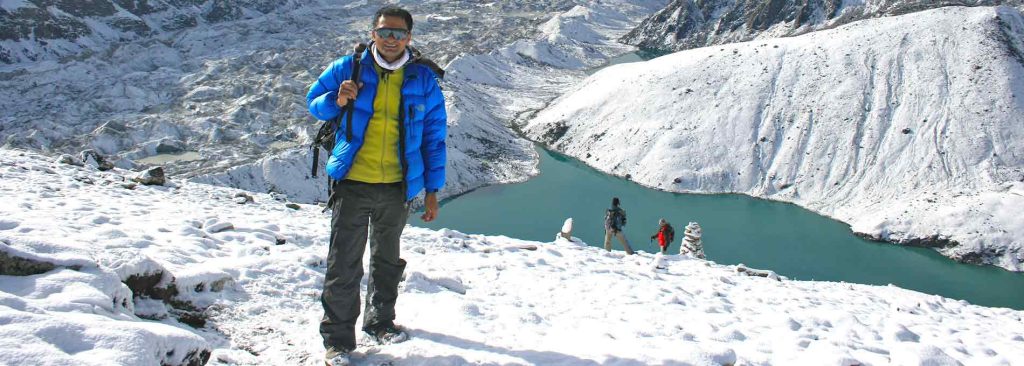
Nepal’s allure for solo adventurers stems from its diverse offerings, combining natural splendor, thrilling activities, and a welcoming environment. Here’s why it stands out as a top destination for solo travel in 2025:
- Breathtaking Landscapes: Nepal is home to eight of the world’s ten highest mountains, including Mount Everest. The Himalayas provide a dramatic backdrop for trekking, with routes ranging from beginner-friendly day hikes to challenging multi-day expeditions like the Annapurna Circuit Trek. The country’s Global Biodiversity Index score of 102.56 ensures a rich experience for nature lovers.
- Adventure Activities: From the iconic Everest Base Camp Trek to white-water rafting in Chitwan National Park, Nepal is an adventure playground. Solo travelers can also enjoy canyoning, paragliding, and mountain biking, catering to various thrill levels. Our Chitwan National Park Tour offers a perfect blend of wildlife safaris and river adventures.
- Welcoming Locals: Nepalese are renowned for their hospitality, making solo travelers feel at ease. In urban areas like Kathmandu and Pokhara, many locals speak English, simplifying communication. For trekkers, mandatory local guides, as required since March 2023, ensure safety while offering cultural insights and companionship through stays at village teahouses.
- Affordability: Nepal is one of Asia’s most budget-friendly destinations. With an average meal costing just £1.40 (approximately NPR 240), travelers can savor local cuisine like mo:mo and dal bhat without straining their wallets. Accommodation options, from basic teahouses to luxury hotels, cater to all budgets, making it ideal for solo travelers.
- Safety: With a safety score of 2.07, Nepal is a secure destination for solo travelers, including solo female travelers. Its traveler-friendly visa policies, including visa on arrival or eVisa for stays up to 150 days, make planning hassle-free. Nepal’s accessibility and safety make it a top choice for independent adventurers.
Top Solo Adventure Experiences in Nepal
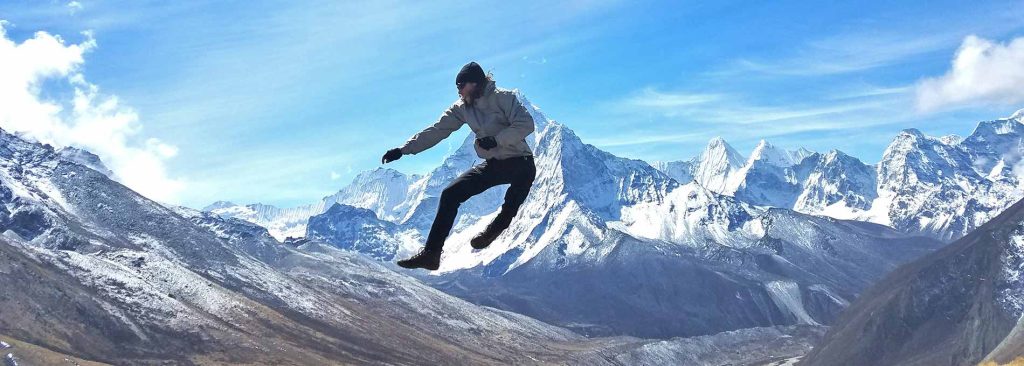
Nepal’s ranking is bolstered by its diverse range of experiences, perfect for solo adventurers seeking both adrenaline and cultural enrichment. Here are some highlights:
- Trekking to Everest Base Camp
The Everest Base Camp Trek is a bucket-list adventure that takes you through Sherpa villages, lush forests, and rugged Himalayan terrain. The journey offers stunning views of Mount Everest and a deep dive into Sherpa culture. With our experienced guides at Nepal Mountain Trekkers, solo travelers can enjoy a safe and enriching experience.
Best for: Trekkers and adventure seekers.
Why it’s solo-friendly: Mandatory guides and teahouse stays foster a sense of community. - Wildlife and Rafting in Chitwan National Park
Chitwan National Park, a UNESCO World Heritage Site, is a biodiversity hotspot home to one-horned rhinoceroses, Bengal tigers, and diverse bird species. Solo travelers can enjoy thrilling white-water rafting on the Rapti River, jungle safaris, or canoe rides to spot wildlife. Our Chitwan National Park Tour is designed to connect solo travelers with like-minded adventurers.
Best for: Nature lovers and thrill-seekers.
Why it’s solo-friendly: Group activities and guided tours make socializing easy. - Cultural Exploration in Kathmandu and Pokhara
Kathmandu, Nepal’s vibrant capital, is a treasure trove of ancient temples, bustling markets, and historic sites like Swayambhunath (Monkey Temple) and Boudhanath Stupa. Our Kathmandu City Tour offers solo travelers a chance to explore these cultural gems with expert guides. Pokhara, nestled against the Annapurna range, offers serene lakes, paragliding, and a relaxed atmosphere perfect for unwinding.
Best for: Culture enthusiasts and explorers.
Why it’s solo-friendly: English-speaking locals and vibrant traveler communities make it easy to connect.
Table: Top Solo Adventure Activities in Nepal
| Activity | Location | Highlights | Best For |
|---|---|---|---|
| Everest Base Camp Trek | Khumbu Region | Stunning Himalayan views, Sherpa culture, challenging trails | Trekkers, adventure seekers |
| Rafting and Safaris in Chitwan | Chitwan National Park | Wildlife spotting, white-water rafting, jungle exploration | Nature lovers, thrill-seekers |
| Cultural Exploration | Kathmandu & Pokhara | Ancient temples, vibrant markets, serene lakes, paragliding | Culture enthusiasts, explorers |
Practical Information for Solo Travelers
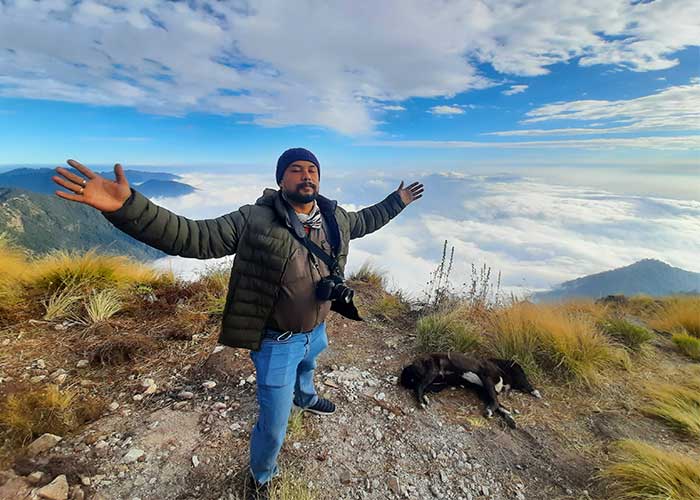
Planning a solo trip to Nepal is straightforward, thanks to its accessible infrastructure and traveler-friendly policies. Here’s what you need to know:
- How to Get There: The primary gateway is Tribhuvan International Airport in Kathmandu. Flights from London take approximately 11 hours and 30 minutes, with several airlines, including Qatar Airways and Turkish Airlines, offering direct and connecting options from major global cities.
- Visa Requirements: Tourists can obtain a visa on arrival or apply for an eVisa for Nepal online. Visas are available for 15, 30, or 90 days, with the option to extend up to 150 days, making long-term exploration feasible.
- Best Time to Visit: The optimal seasons for trekking and outdoor activities are spring (March to May) and autumn (September to November), when clear skies and mild temperatures enhance the experience.
- Accommodation Options: Trekkers can stay in teahouses along trails, offering basic but cozy lodging. In cities, options range from budget hostels to luxury hotels, ensuring flexibility for all budgets. Check out our Solo Travel Packages for tailored accommodation options.
- Biodiversity and Accessibility: Nepal boasts a Global Biodiversity Index score of 102.56, making it a paradise for nature lovers. Its accessibility, combined with affordability, ensures solo travelers can explore without logistical hurdles.
Table: Practical Travel Details for Nepal
| Aspect | Details |
|---|---|
| Main Airport | Tribhuvan International Airport, Kathmandu |
| Flight Time from London | ~11 hours 30 minutes |
| Visa Options | Visa on arrival or eVisa (15, 30, or 90 days, extendable to 150 days) |
| Best Travel Seasons | Spring (March–May), Autumn (September–November) |
| Average Meal Cost | £1.40 (approx. NPR 240) |
| Safety Score | 2.07 (highly safe for solo travelers) |
Why Choose Nepal Mountain Trekkers?
At Nepal Mountain Trekkers, we specialize in crafting unforgettable adventures for solo travelers. Our expert guides, personalized itineraries, and commitment to safety and sustainability ensure a seamless and enriching experience. Whether you’re embarking on the Everest Base Camp Trek, exploring Chitwan National Park, or discovering the cultural treasures of Kathmandu with our Kathmandu City Tour, we’re here to make your solo journey unforgettable. Our Solo Travel Packages are designed to cater to independent travelers, offering flexibility and support every step of the way.
Conclusion
Nepal’s ranking as the 7th best solo adventure destination for 2025 by Much Better Adventures reflects its unparalleled blend of natural beauty, thrilling activities, and welcoming culture. For solo travelers eager to push their limits, immerse in new cultures, and create lasting memories, Nepal is a must-visit destination. Whether you’re scaling Himalayan peaks, rafting through jungles, or wandering ancient streets, Nepal promises an adventure that captivates both heart and soul. Start planning your solo adventure with Nepal Mountain Trekkers today and discover why Nepal is the ultimate destination for thrill-seekers and culture enthusiasts in 2025.
Explore More with Nepal Mountain Trekkers
Ready to embark on your solo adventure in Nepal? Explore our curated packages and treks:
- Everest Base Camp Trek
- Annapurna Circuit Trek
- Chitwan National Park Tour
- Kathmandu City Tour
- Solo Travel Packages
2025
Top 10 Treks in Nepal for 2026 Mar/Apr/May
Hey there, adventure lovers! Are you ready to lace up your boots and hit the trails in Nepal? The Himalayas are calling, and 2026 is gonna be an epic year for trekking in Nepal. With new routes popping up and a big focus on sustainable tourism, there’s something for everyone—whether you’re a newbie or a pro trekker. I’ve been lucky enough to explore some of these trails myself, and let me tell you, the views and vibes are out of this world!
In this blog, I’m sharing the top 10 treks in Nepal for 2026 that are trending big time. These are the ones folks from the US, Australia, Canada, Germany, and even Nepal itself are raving about. So, grab a coffee, get comfy, and let’s dive into these Top 10 Treks in Nepal 2026 – the must-do adventures!
List of Top 10 Treks in Nepal for 2026:
1. Everest Base Camp Trekking 2026
This is the big one—Everest Base Camp Trek 2026! Standing at the foot of the world’s highest mountain is a bucket-list moment. The trail winds through Sherpa villages, past monasteries, and offers jaw-dropping views of the Khumbu Icefall. I remember my first glimpse of Everest; it gave me goosebumps!
- Best Time: March to May, September to November
- Duration: 14 to 16 days
- Difficulty: Moderate
- Why Go: Stunning Himalayan views, rich Sherpa culture, and that unbeatable sense of achievement.
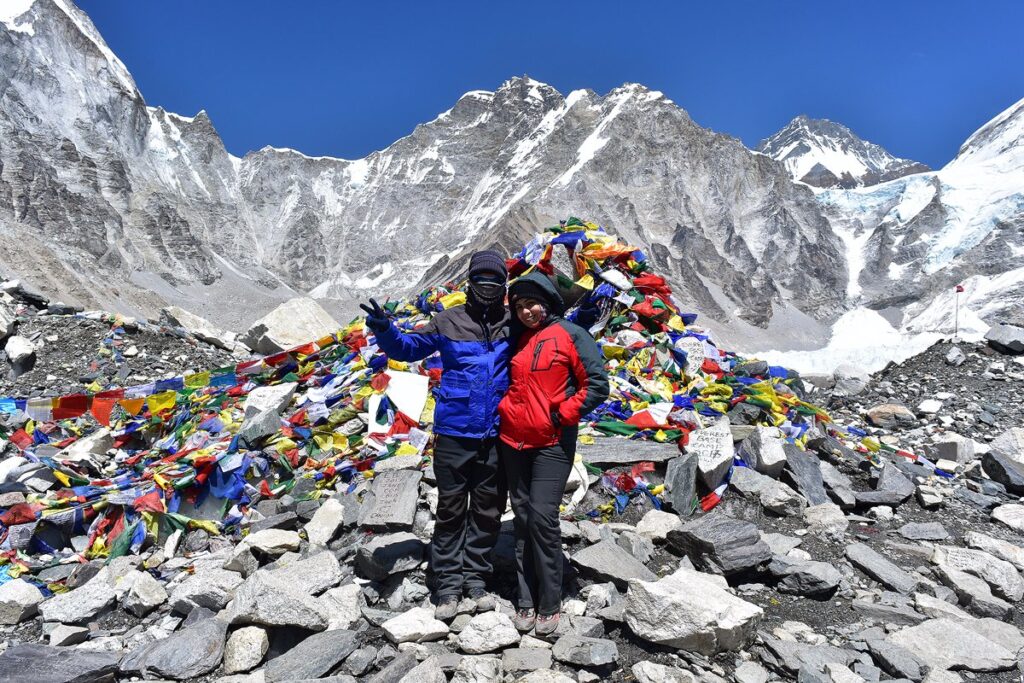
Plan your Everest Base Camp Trekking adventure with Nepal Mountain Trekkers.
2. Everest Three High Passes Trek 2026
If you’re up for a serious challenge, the Everest Three High Passes Trek is your jam. You’ll cross three epic passes—Renjo La, Cho La, and Kongma La. It’s tough, but the views of snow-capped peaks and glaciers make it so worth it.
- Best Time: March, April, September, October, November
- Duration: 18 to 21 days
- Difficulty: Very Strenuous
- Why Go: Thrilling high-altitude passes and unmatched scenery.
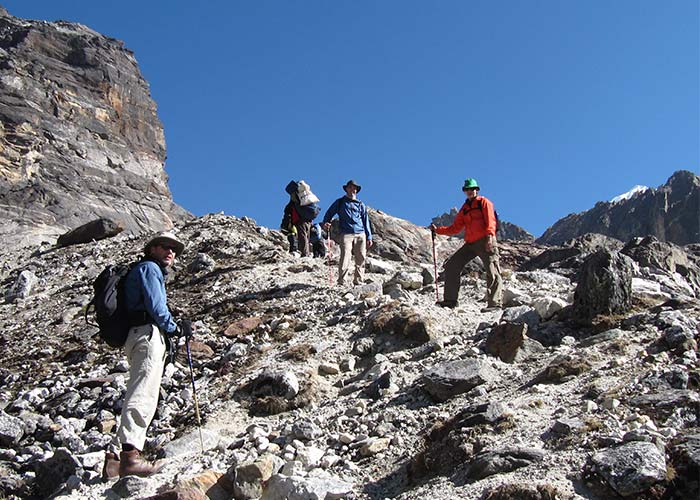
Check the Everest Three High Passes Trek itinerary and cost details with Nepal Mountain Trekkers.
3. Annapurna Circuit Trek 2026
The Annapurna Circuit Trek 2026 is a classic for a reason. It’s got everything—lush forests, high-altitude deserts, and views of Annapurna and Dhaulagiri. You’ll pass through Gurung villages and cross the Thorong La Pass. It’s like a journey through different worlds!
- Best Time: September to November, March to May
- Duration: 14 to 21 days
- Difficulty: Moderately difficult
- Why Go: Diverse landscapes and cultural immersion.

Book your Annapurna Circuit Trek with Nepal Mountain Trekkers.
4. Upper Mustang Trekking 2026
Upper Mustang is like stepping into a time machine. This ancient kingdom, with its Tibetan vibes, has red cliffs and monasteries that feel straight out of a movie. The landscape is unreal, and the culture is so unique. Besides trekking, Upper Mustang Jeep Tour, Upper Mustang Horse Riding, and Upper Mustang Mountain Biking Tour are also popular activities in the Mustang region of Nepal.
- Best Time: March to November
- Duration: 14 to 21 days
- Difficulty: Moderate
- Why Go: Unique desert scenery and ancient monasteries.
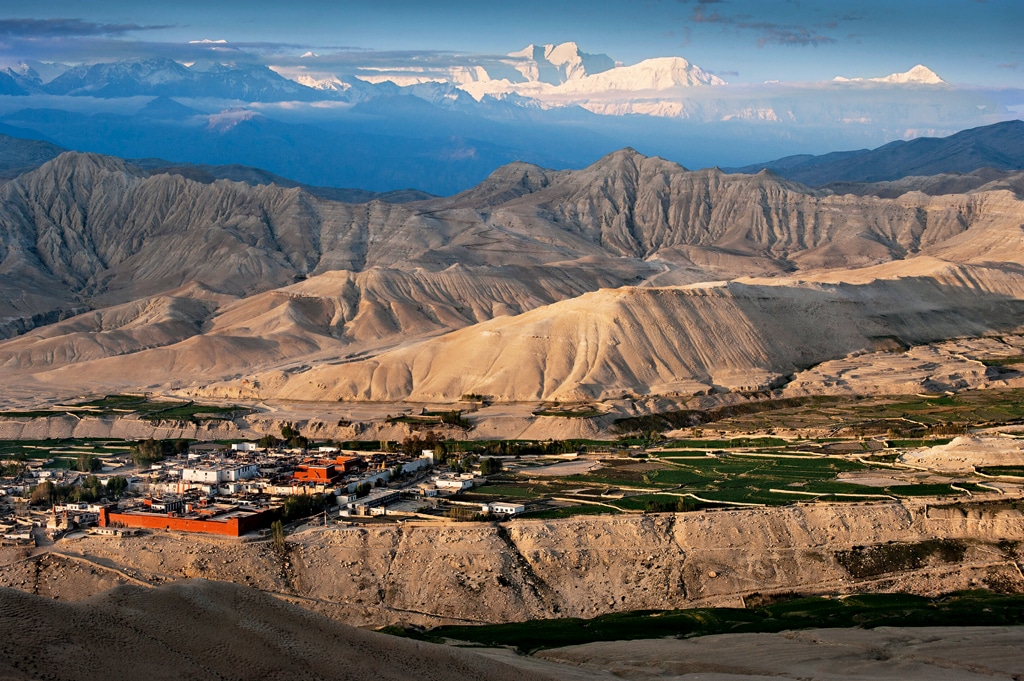
Explore more about Upper Mustang Trekking itinerary, cost, and other details with Nepal Mountain Trekkers.
5. Manaslu Circuit Trekking 2026
The Manaslu Circuit Trek is a hidden gem for those who want to escape the crowds. You’ll trek past the eighth-highest mountain, Manaslu, and through Gurung and Tibetan villages. The hospitality here is heartwarming!
- Best Time: March to May, September to November
- Duration: 13 to 17 days
- Difficulty: Challenging
- Why Go: Pristine landscapes and authentic cultural experiences.
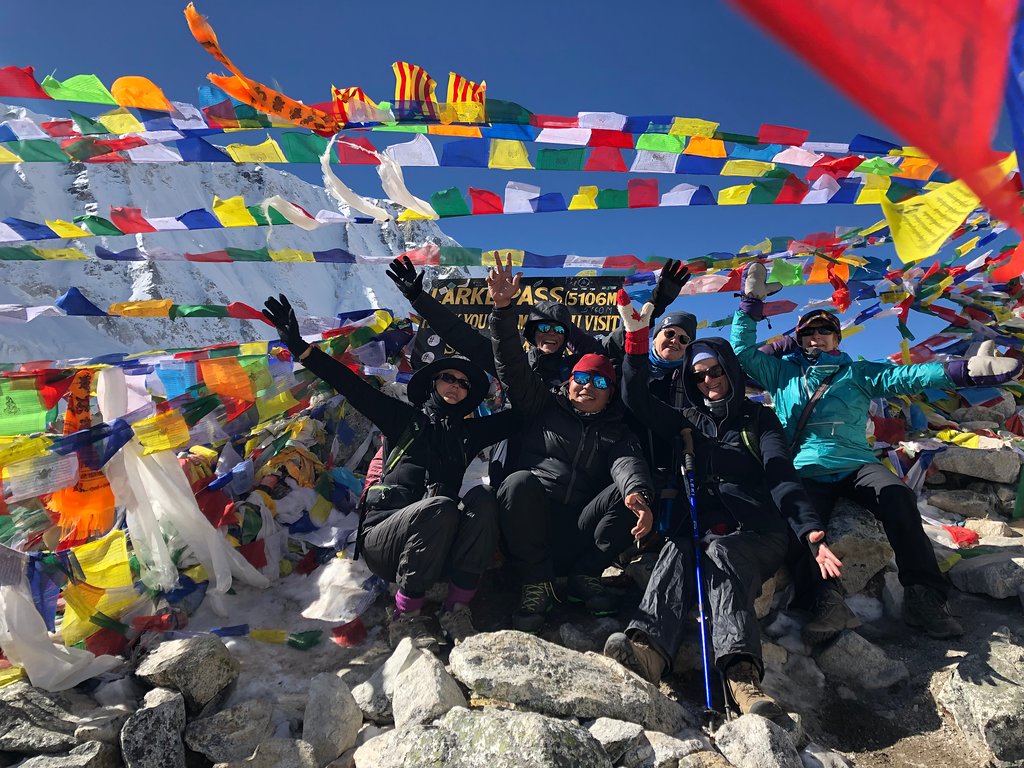
Get details about Manaslu Circuit Trekking at Nepal Mountain Trekkers.
6. Langtang Gosainkunda Trekking 2026
If you’re after peace and quiet, the Langtang Gosainkunda Trek is perfect. The Langtang Valley has lush forests and cozy villages, plus the sacred Gosainkunda Lakes, which are super spiritual. It’s less crowded but just as beautiful.
- Best Time: October, November, March to May
- Duration: 12 to 16 days
- Difficulty: Moderate
- Why Go: Serene beauty and spiritual significance.
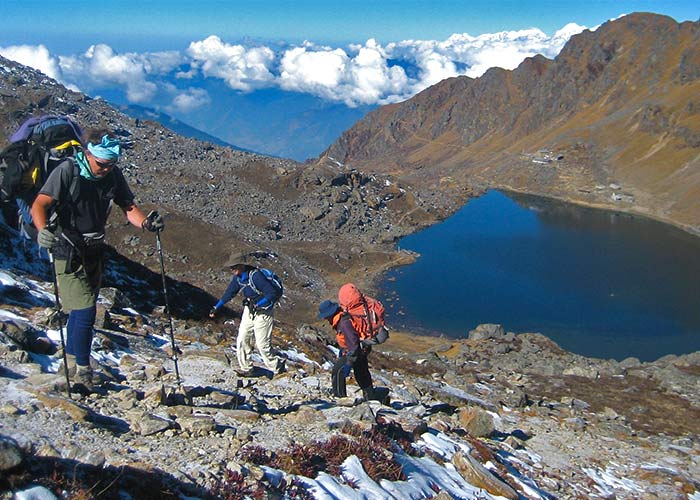
Plan Langtang Gosainkunda Trekking with Nepal Mountain Trekkers.
7. Rara Lake Trekking 2026
Rara Lake Trek takes you to Nepal’s largest lake, tucked away in a remote national park. It’s a bit off the radar, which makes it perfect for those who love untouched nature and spotting wildlife.
- Best Time: September to November, March to May
- Duration: Minimum 6 days
- Difficulty: Moderate
- Why Go: Tranquil lake views and rare wildlife sightings.
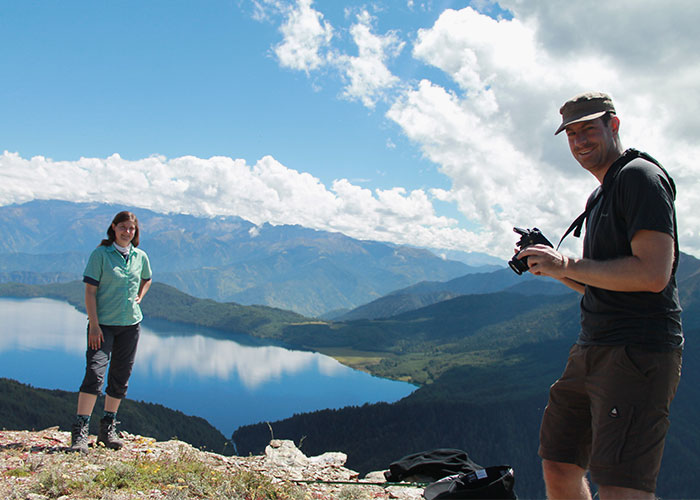
Book Rara Lake Trekking now at Nepal Mountain Trekkers.
8. Rolwaling Valley Trekking 2026
Rolwaling Valley is a hidden treasure with snow-capped peaks and serene forests. The Tso Rolpa Lake is a highlight, and the villages along the way are so welcoming. It’s a trek for those who want adventure without the hustle.
- Best Time: March to May, September to mid-December
- Duration: 12 to 19 days
- Difficulty: Moderate
- Why Go: Peaceful trails and stunning mountain views.
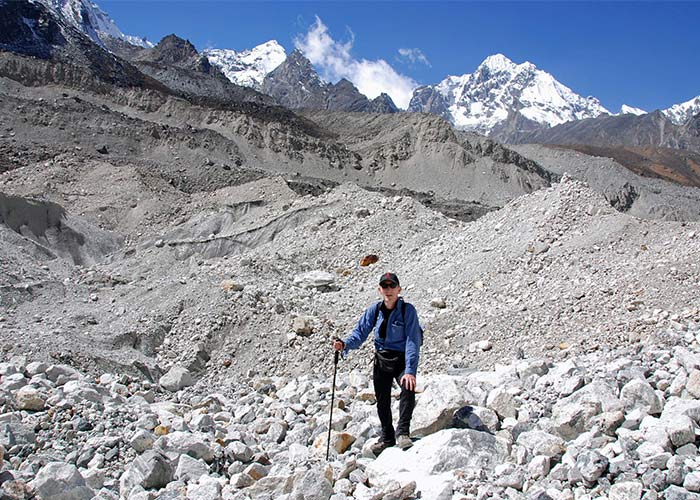
Find out more about Rolwaling Valley Trekking at Nepal Mountain Trekkers.
9. Annapurna Base Camp Trekking 2026
The Annapurna Base Camp Trek 2026 is a shorter but epic adventure. You’ll stand at the foot of Annapurna I, surrounded by towering peaks like Machhapuchhre (Fishtail). The Gurung villages add a cultural touch that’s hard to beat.
- Best Time: March to May, mid-September to mid-December
- Duration: 8 to 15 days
- Difficulty: Moderate
- Why Go: Breathtaking views and charming villages.
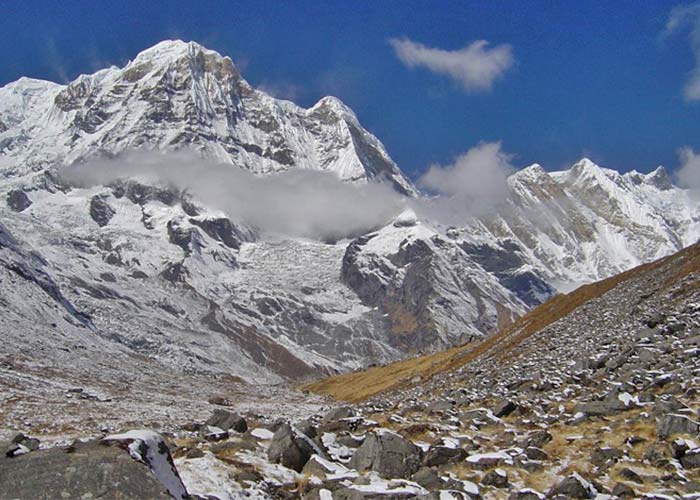
Book your Annapurna Base Camp Trek at Nepal Mountain Trekkers.
10. Khopra-Danda Trek 2026
Last but not least, the Khopra-Danda Trek is a lesser-known gem in the Annapurna region. Think panoramic views of Annapurna and Dhaulagiri, plus trails lined with blooming rhododendrons in spring. It’s a quieter option for nature lovers.
- Best Time: March to May, mid-September to mid-December
- Duration: 7 to 14 days
- Difficulty: Moderate
- Why Go: Less crowded trails and stunning vistas.
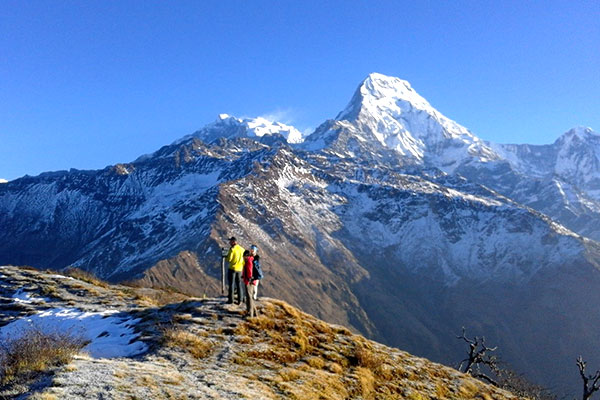
Discover the Khopra-Danda Trek at Nepal Mountain Trekkers.
Sustainable Trekking in Nepal 2026 – Top 10 Treks in Nepal for 2026 Mar/Apr/May and 2026 Sept/Oct
Eco trekking Nepal 2026 is a big deal these days. More and more operators are focusing on sustainable trekking in Nepal, using local guides, supporting communities, and cutting down on waste. When you pick your trek, go for a company that cares about the environment and locals—it makes your adventure even more meaningful!
Tips for Your Top 10 Trek in Nepal for 2026
- Pack Smart: Bring sturdy boots, a good camera, and extra snacks (trust me, you’ll need ‘em!).
- Stay Safe: Watch out for altitude sickness and follow your guide’s advice.
- Connect: Chat with locals along the way; their stories make the trek unforgettable.
Why These Top 10 Treks in Nepal for 2026 Are Trending
These treks are drawing crowds from places like Germany, India, and Nepal itself, based on recent booking trends. Whether it’s the iconic Everest Base Camp Trek or the remote Rara Lake, each offers something special. Plus, with new treks in Nepal 2026 gaining attention, there’s no shortage of options.
Conclusion: Top 10 Treks in Nepal for 2026
There you go—the top 10 treks in Nepal for Sept to November 2026 and March to May 2026! From the thrill of Everest to the calm of Rara Lake, these adventures are sure to leave you with memories that last a lifetime. So, what’re you waiting for? Start planning, pack your bags, and get ready to explore the Himalayas. Which one of the top 10 treks in Nepal for 2026 is calling your name? Contact us and let us know!
Happy trekking in Nepal 2026!
2025
Gosaikunda Trek: An emotional and spiritual trekking place in Nepal
Around 2pm, our bus left us behind at Dhunche. The clouds looked heavy, and the cold breeze hinted at rain. I unwillingly purchased a raincoat from a local shop, a decision I would soon be thankful for. As we started our trekking towards Gosaikunda Lake, tea breaks became our energy drinks. Each cup of tea from the small and local tea houses along the trail warmed not only our hands but also our spirits. We needed it because, not long after we started walking up hill, the rain decided to join our Gosaikunda trek. The visibility was poor, and the little drizzle of rain made the paths slippery. So, we took short breaks and even adjusted our itinerary, deciding to stay overnight at Deurali.
The journey up to Deurali was pleasant despite the rain. On the way, we passed a small river and some houses where two little kids peeked shyly at us from behind the door. Their innocence made me pause and smile. These little moments are what makes Nepal trekking so special – the people, their simplicity, and the raw beauty of their livelihood.
We reached Deurali feeling exhausted and cold. Altitude sickness was a concern, so we decided to take the trek slow and not hurry. The next morning, after brushing my teeth and stepping outside for fresh air, my eyes were pleased by a view I will never forget. The snow-covered mountains stood tall and I felt those mountains were looking directly into my eyes. It felt unreal – like the mountains were close enough to touch.
This was my first time being so close to the Himalayas, and my excitement knew no bounds – always grateful for the Gosaikunda Lake Trek. I ran back inside, shouting at my still-asleep friends to wake up and witness the view. Sleepy and slightly annoyed at me for waking them up, they came outside, but their angry faces quickly turned into wide smiles. Suddenly, everyone was cheering and laughing. The mountains had a magical effect on all of us.
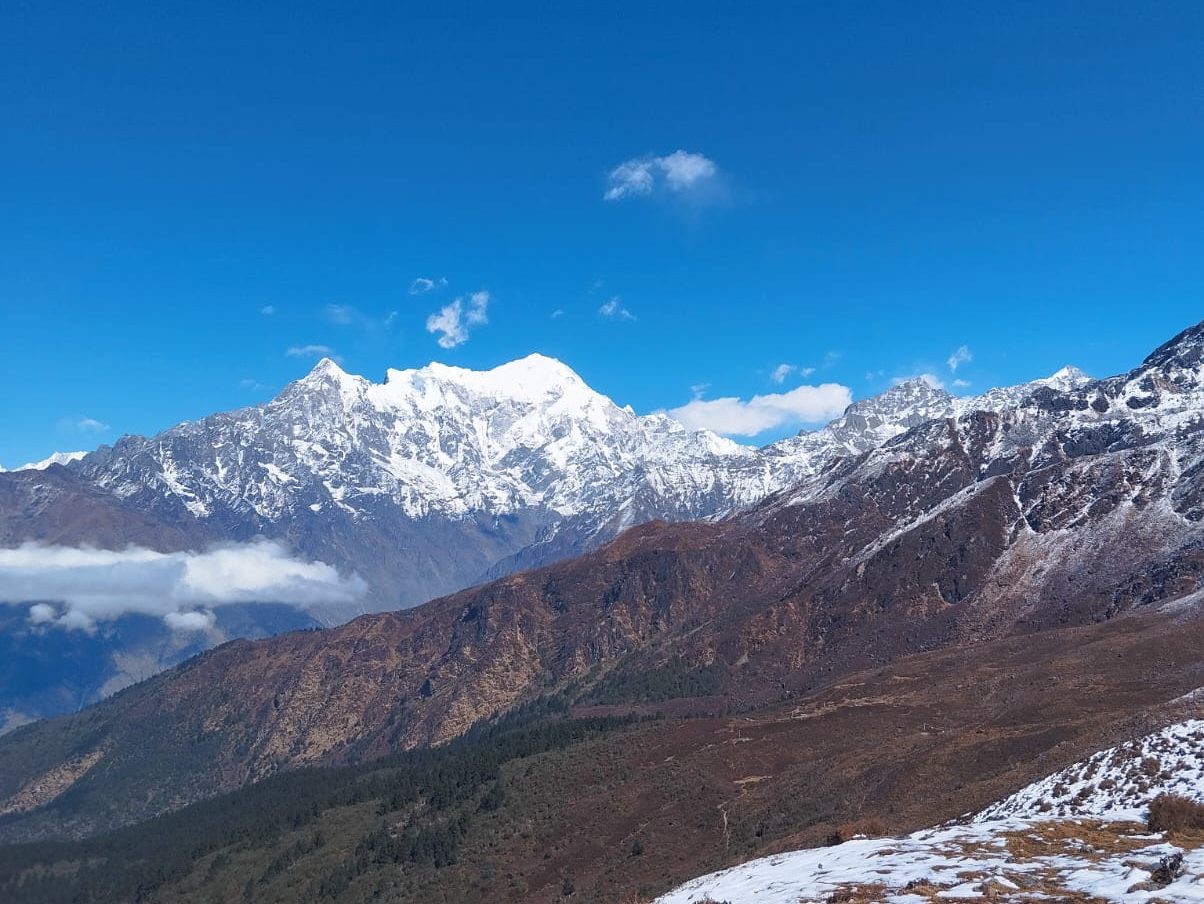
The cold was biting that morning, and the water in the taps was barely touchable – it felt like ice! We were trekking in early November, and the chill was as real as the adventure. After a light breakfast and clicking countless photos of the stunning mountains, we group of seven hit the trail again after drinking hot cup of tea for warming ourselves.
The landscape seemed to change as we come closer to the lake. We saw breathtaking views of the Himalayas, horses grazing peacefully in the fields, and local villagers gathering wood for their evening fires. The cold air kissed our faces as we walked, and the friendship of our group made it even more enjoyable. We sang songs, cracked jokes, and shared snacks along the way until we reached Cholang Pati for our long-waited Dal Bhat.
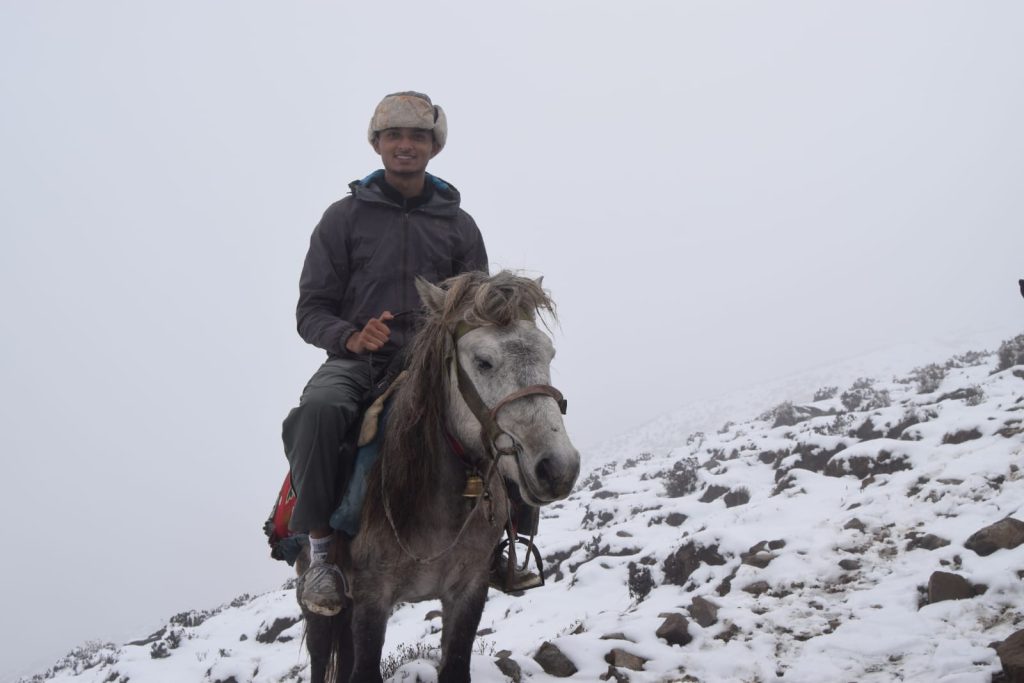
“Dal-bhat power 24 hour” is common and famous phrase among tourist and Nepalese people.
At Cholang Pati, we stopped for lunch, simple yet delicious dal bhat. This spot was like a heaven, surrounded by towering mountains on all sides. After eating, we spent some time playing local instruments that the tea house owner had. Some of us even tried horse riding, a fun activity available for trekkers who might find walking challenging local dish. Gosaikunda lake trekking offers options for everyone, whether you’re trekking on foot or on horse.
With time running short, we decided to head straight to Gosaikunda lake with elevation of 4,380 meters. The higher we went, the colder it got. The fog surrounded us limiting our visibility, and by the time we reached on top, it was almost night. It was hard to see anything because of the fog, and we were shivering from the cold. However, we received a warm welcome at one of the lodges. Many hotels were closed for the season, but the ones that remained open worked together to serve trekkers like us. The owner’s dedication to run these lodges in such harsh conditions amazed me. If they were not there to serve us, the Gosaikunda lake trek would be one of the hardest treks in Nepal.
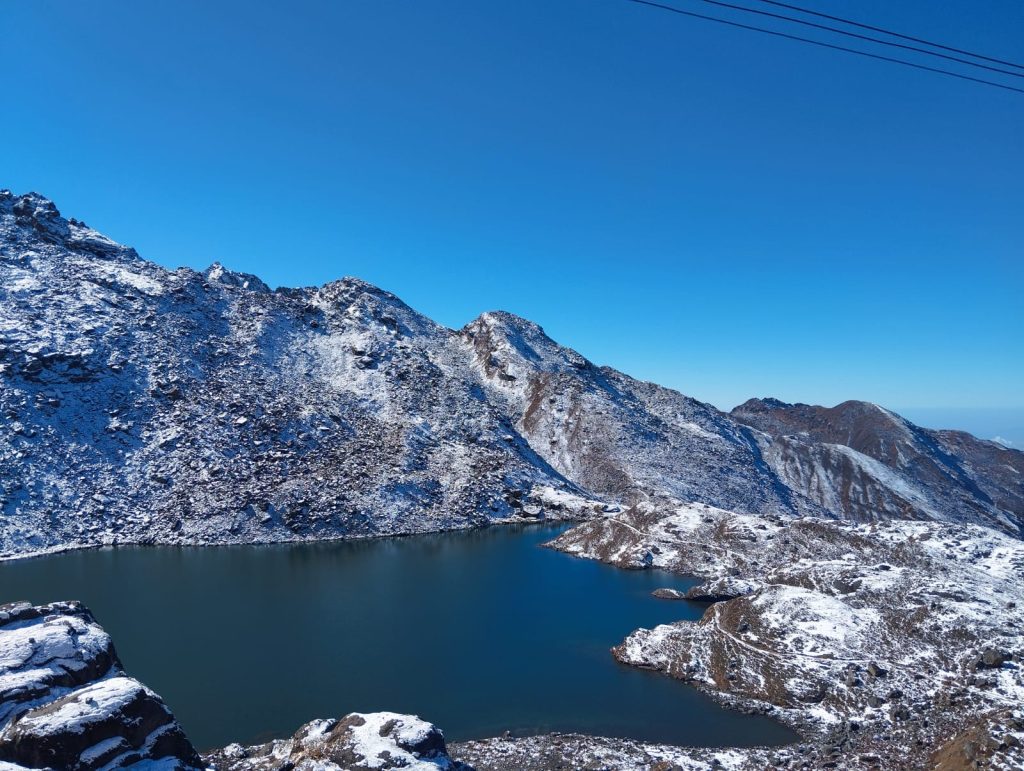
We spent the evening sitting around a fireplace in the lodge’s main hall, sharing stories and laughter with strangers. We were all united by the divine journey and energy of the Gosaikunda lake Trek. It didn’t matter that we didn’t know each other’s names or backgrounds; the cold had united us together. That evening, surrounded by warmth and laughter, felt like one of the best moments of my life.
The next morning, I was woken by some noise outside the lodge. Curious, I grabbed my jacket and stepped out. What I saw left me speechless. The fog was no were to be found, and right before me was Gosaikunda Lake, its shiny blue surface surrounded by rugged and snow-capped mountains. It felt like a dream. Me and my friends, we all ran down to the lake, our excitement left the ground after seeing what we were talking about the other day.
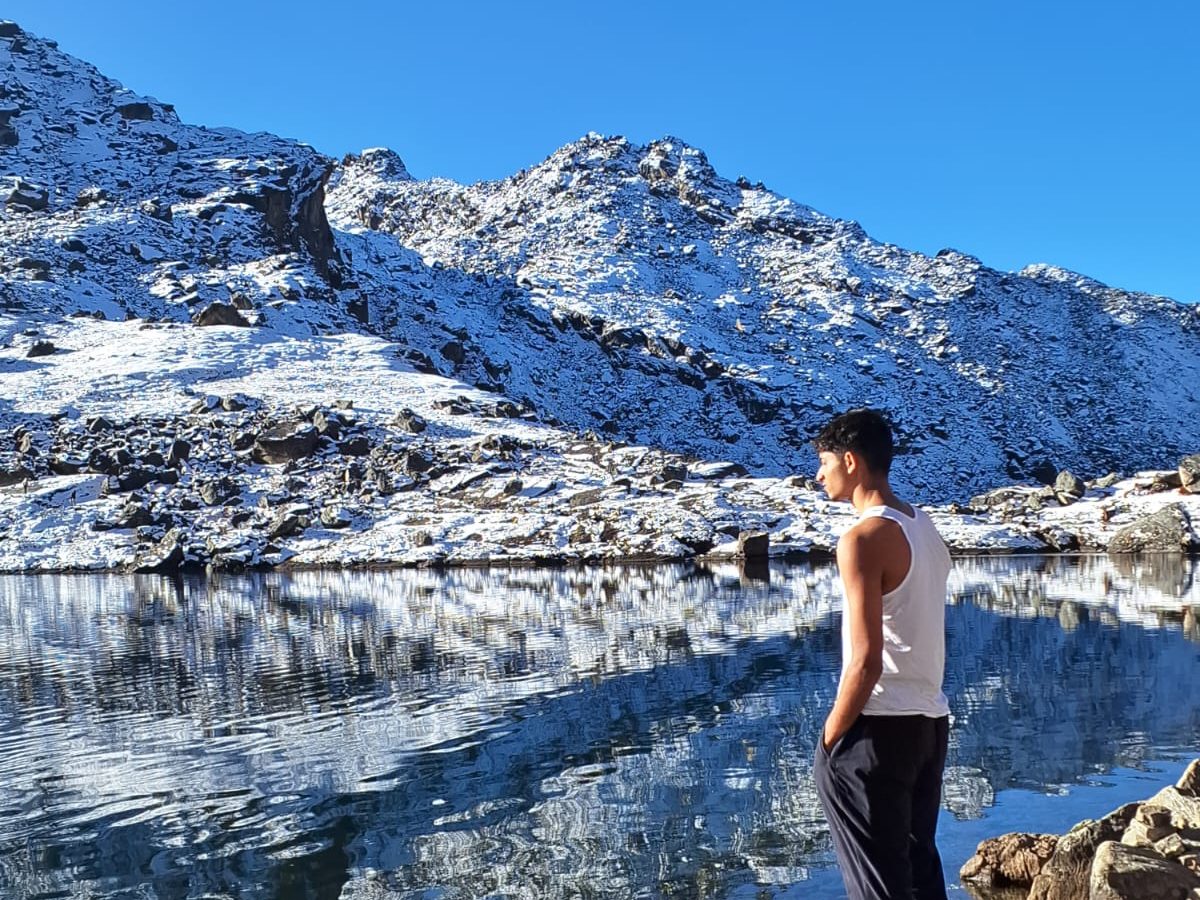
The lake is considered holy in Hindu tradition and is believed to have been created by Lord Shiva. People often say, if we look closely inside the water, we can find lord Shiva resting down. We tried seeing but could not see properly. There’s a small temple near the lake, and many pilgrims visit to offer prayers and sprinkle the lake’s holy water in their homes for blessings. We spent some time at the temple praying for our family members and our loved once. Then someone from our group had a crazy idea: why not take a dip in the lake?
The water was freezing, so cold that just touching it sent shivers down our spines. But the belief that a holy dip would erase our sins gave us purpose to take a dive. Laughing and shivering, we brought our extra clothes and started taking our cloths off. We all seven of us jumped into the icy water. Just to let you know, we were there only for few seconds. The cold was unbearable, and my feet felt numb for a while, but the experience was unforgettable – a really remarkable experience during the Gosaikunda Lake Trek.

Afterward, we rushed back to the lodge for a hot cup of tea, wrapped ourselves in blankets, and just started laughing with no reason. The lake, the mountains, the freezing water, all of it felt something so raw and pure.
Gosaikunda lake trekking is truly one of the best trekking experiences in Nepal. The combination of rugged trails, untouched landscapes, and cultural richness makes it unique trekking trails than other places. It’s more than just a physical journey; it’s more likely an emotional and spiritual journey. If you’re planning to experience trekking in Nepal, Gosaikunda Lake located at Langtang region is enough for the needed challenges and rewards that last a lifetime. As I sit here writing this, I can still feel the cold air and hear the sound of our laughter. Gosaikunda is a place that will stay forever with me.
